Are you searching for the best type of flower to gift to that special someone?
Flowers are a universal language that can convey all kinds of feelings. Whether you want to convey your love and devotion, or just want to say thank you, flowers are a great way to send a message. Flowers can help you express your feelings without having to say anything at all (especially if you have trouble expressing yourself).
Discover which bouquet conveys exactly what you want to say with our guide to types of flowers and their meanings.
With Direct2Florist, shopping for the right flowers for your special occasion has never been easier.
Whether you're looking for a simple centrepiece or something more elaborate, we've got you covered.
Ready to scrub up on your flower knowledge? Let’s get started!
Popular types of flowers from A-Z: Names, occasions and meanings explained
Flowers are a beautiful part of our natural world and there are many different types.
Knowing your flowers can make all the difference when it comes to choosing from the myriad of flower options available on the market today. Whether you’re looking for flowers for a wedding, a funeral, a birthday or an anniversary, understanding the deeper meanings and symbolism of flowers will help you in your flower-buying venture.
Lisianthus - a patient reward
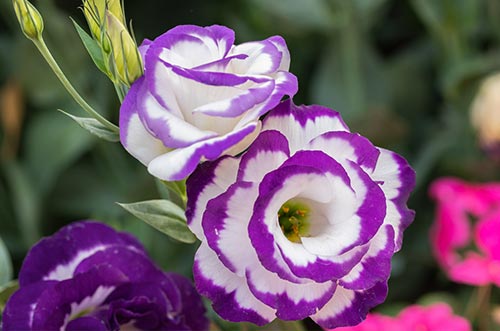
The lisianthus is another flower with several names, also known as the eustoma or prairie gentian.
The term prairie gentian comes from the area in which this flower is naturally found - the prairies of North America. However, these plants are also grown in South America, Mexico and the Caribbean.
The lisianthus is a herbaceous perennial that can also be grown as an annual in cooler weather, adding a great deal of variety to this plant. What makes these flowers more uncommon is the fact that they can take quite a while to grow - up to 20 months in some situations.
However, being patient is its own reward, as these gorgeous bell-shaped flowers bloom in the following colours: purple, pink, blue and white. Multicoloured variations are also popular. The bold nature of these plants means they’re often used to show appreciation for other people, adding another use for them.
Origin:Lisianthus flowers originate in North America, Mexico, the Caribbean and South America
Vase life:Generally 7-14 days
Colour range:They can bloom in multicoloured or single colour varieties, including pink, purple, blue and white
Best occasion:As lisianthus plants are a common symbol of appreciation and gratitude, they make ideal thank you gifts for friends and family
Symbolism:Appreciation, confidence, gratitude, charisma, charm
Morning Glory - the beginner's bloom

Morning glory is actually a term used to describe over 1,000 variations of flowering plants in the convolvulaceae family. They also belong to numerous genera, making them extremely variable flowers.
Morning glory flowers are trumpet-shaped. The most commonly seen colour is blue, although pink, orange, purple and multicoloured forms are also popular.
Morning glories are annual climbers with vivid, colourful blooms.They’re also extremely easy to care for (even as a beginner) and bloom for a relatively long time for such a flower. They’ll self-seed once initially planted and are drought-resistant, making them effortless to cultivate. Pollinators love morning glory plants, so they’re great if you want to attract them to your garden.
Whilst there are many different varieties of this plant, the majority of them (such as the commonIpomoea purpurea) are found in Central and South America. They grow rapidly - these plants are considered to be an invasive species or a pest in some countries due to their ease of growth. The American state of Arizona has banned the cultivation and sale of the morning glory flower because of this.
Some morning glory plants may also be eaten - they have a distant relationship with the sweet potato, sharing the same genus. Morning glory seeds are also sometimes eaten by people chasing a psychedelic experience, due to these seeds containing a psychoactive chemical called LSA.
Origin:Central and southern America
Vase life: Morning glories have quite a short vase life - usually only a couple of days
Colour range:Blue, orange, purple, pink, multicoloured
Best occasion:Their connection with love makes them great bouquets to give for anniversaries or weddings
Symbolism:These flowers have many meanings, but they’re often connected with love (sometimes unrequited or painful love), death and life
Alstroemeria - fortune in friendship
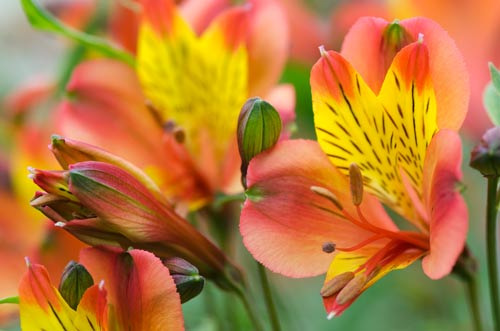
Alstroemeria (also known as Peruvian lily) is a beautiful, elegant flower that makes a statement on its own, or as part of a bouquet. It consists of approximately 50 species, with most species growing between 8 and 20 inches tall. Its simple beauty and long-lasting trumpet-flute petals make it one of the more popular florist flowers.
These flowers are known for their bright colours and long vase life, making them perfect luxury flowers for weddings or other special occasions.
Because this flower comes in many colours, giftees can select a hue to represent or evoke a particular emotion. Whether that be yellow for happiness and strength, white for purity and grace or pink for romance and adoration, this versatile flower makes for a gorgeous choice for every situation!
When thinking of that special someone, consider alstroemerias if you want vivid, delicate flowers. For allergy sufferers, this variant of the flower is ideal due to the complete lack of scent.
Origin:Peru, Brazil and the mountains of Chile
Vase life:7-14 days
Colour Range:White, pink, yellow and red are the most common colours
Best occasion:Often used as a wedding flower or part of a valentines bouquet.
Symbolism:Most commonly known to be symbolic of friendship, romantic love and devotion(colour dependant).
Dahlia - everlasting love
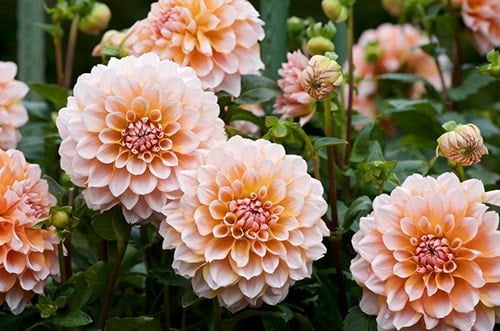
For a flower that embodies luxury, elegance, and beauty, look no further than the dahlia.
The dahlia, with its distinctive blooms and vibrant colour, has long been a staple of floral arrangements. With over 100 varieties, dahlias are a versatile choice for any occasion.
These flowers have a rustic appearance that pairs perfectly with your favourite suit or dress, and their simplicity makes them perfect for any occasion. Their wide blooms make them a popular choice for flower arrangements.
Cactus dahlias have a unique, cactus-like shape that's perfect for adding a little extra flair to a bouquet. Pompon dahlia blooms are another great option if you're looking for something a little more old-fashioned - these blooms are ball-shaped and look very ornamental against dark green foliage.
Origin:Dahlias are Mexico’s national flower, but are grown across Europe
Vase life:Most variants last up to 5 days, with others lasting up to 7.
Colour Range:This fragrant flower is available in a wide range of colours: whites, pinks, reds, oranges and purples.
Best occasion:According to the language of flowers, dahlias symbolises gratitude, making these flowers a lovely ‘thank you’ gift.
Symbolism:The traditional meaning of the dahlia flower is that it represents love, joy and happiness.
Daisy - the delight of spring meadows

Daisies are a great gift for anyone. They're bright and cheery, and you can't help but smile when you see them. They're also versatile flowers - they look great as cut flowers or in a bouquet, and they can be used in all kinds of arrangements. So whether you're giving flowers to your mum on Mother's Dayor your best friend at work, daisies are sure to please!
It’s no secret that the daisy we all know best (vivid yellow centre and petite tear-drop petals) radiates happiness. This long association with cheerfulness and radiance is what makes this flower so special and favourable amongst many.
However, you may be surprised to learn that there are actually more than 200,000 other species of daisies including the English daisy, the Gerbera daisy and the African daisy. Daisy lovers will be happy to learn that most variants are available all year round, meaning they can provide endless joy and cheer!
| Fun Fact:The common name daisy originates from the Old English phrase ‘Daes eage’, which means ‘day's eye.’ This name came about because daisies close during the night, and then reopen in the morning. |
Origin:Daisies are native to Europe and Asia, but they can be found in almost every continent (besides Antarctica).
Vase life:Cut daisies will last around 7-10 days
Colour Range: A plethora of colours are available - daisies come in multiple shades of red, pink, white and blue.
Best occasion:As daisies are historically known for their curative qualities, gifting daisies is a thoughtful way of saying ‘get well soon’.
Symbolism:Daisy flowers are often associated with innocence and purity, but they can also represent the fragility of life. They're often seen as a sign of spring and new beginnings.
Carnation - a fragrant flower of love
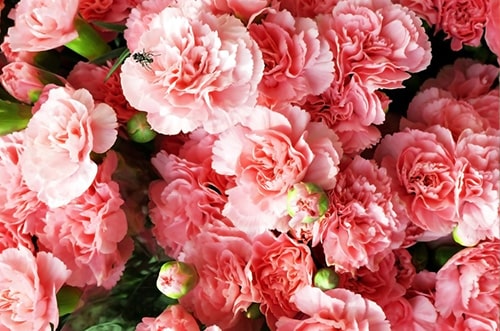
Carnation flowers are a classic choice for many flower arrangements and remain a popular flower choice for an array of celebrations and occasions.
You will find carnations in almost every colour of the rainbow, including red, pink and white - all of which carry significant meaning and symbolism.
Carnations are sweet, delicate flowers that are perfect for placing in the home.
The sweet, delicate fragrance of carnations is perfect for adding a touch of romance to any room.
They're colourful and bright, making them a great choice for birthdays, anniversaries, and other celebrations. Carnations also work well as sympathy flowers for a funeral, especially when paired with other plants like daisies or roses. They're also the birth flower for January, which makes them an excellent choice for anyone born in that month!
| Fun Fact:In some cultures, certain colours or types of carnations are thought to convey different meanings. For example, purple variants are France's traditional funeral flower. This flower also represents motherly love, which is why they're often given as gifts on Mother's Day. |
Origin:The carnation is native to Europe and Asia
Vase life:Up to 14 days or more
Colour Range:Carnations come in a wide range of tones; pink, white and red are the most popular colours.
Best occasion:.Weddings, mother’s day, Valentine’s day and funerals (colour dependent).
Symbolism:Purity, affection, motherly love, gratitude and sorrow
Chrysanthemum - the awe of autumn

If long vase life is what you’re searching for, this flower is for you. Chrysanthemums are one of the longest-lasting cut flowers, offering endless beauty to all that are gifted with them.
Chrysanthemums (also known as ‘mum’) are a beautiful, fragrant flower that is often associated with funerals and cemeteries. However, this does not mean that they can't be used in other ways! We've seen them on wedding bouquets, baby showers, and even as part of home decorating schemes.
Traditionally, the chrysanthemum is considered a beautiful autumn flower since it's one of the most colourful blooms in the season. It is also November’s birth flower, so keep this in mind when purchasing gifts for a November wedding or birthday!
| Fun Fact:Chrysanthemums have been used in herbal medicine since ancient times to treat fever, convulsions and heart disorders. |
Origin:Chrysanthemums are thought to have come from China.
Vase life:Chrysanthemums have a long vase life and can last up to 3 weeks when properly cared for.
Colour Range:You’ll find these flowers in almost every colour of the rainbow, the most popular colour being red, purple and white.
Best occasion: Chrysanthemums represent life and rebirth in Asia, making them an excellent gift for a new baby or baby shower.
Symbolism:They are famous for representing rebirth, well-being and friendship.
Calla Lily - the modern bride's favourite
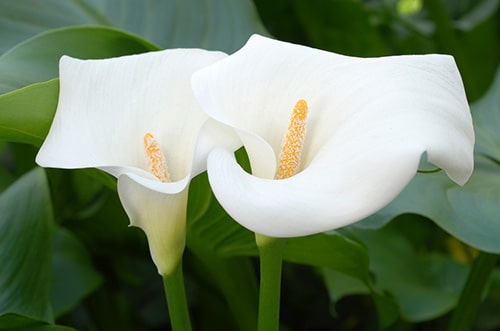
The calla lily is a firm favourite among our customers and is a particularly popular choice for wedding bouquets and corsages. The calla lily is known for its simplicity and elegance, making it an excellent choice for any occasion.
Calla lilies look particularly lovely when displayed with foliage stems and other small flowers. The contrast between their soft cream colour and the bright green of the leaves creates an elegant effect that will be sure to impress your guests.
The calla lily's symbolism varies depending on the colour and place, it's often considered a sign of new beginnings. In others, it signifies mourning and is therefore commonly used as a funeral flower.
| Fun Fact:The word 'calla' is derived from the Greek word for beautiful, and its association with Hera, the goddess of women, marriage and childbirth, makes this flower a favourable symbol for many brides-to-be. |
Origin:The calla lily originated in the wilds of South Africa
Vase life: Around 7-10 days
Colour Range:White, pink, red, black, yellow and purple, all species carry different deeper meanings.
Best occasion:The calla lily's large size and unique shape make it an excellent choice for any event where you want to make an impact - from weddings to birthdays, anniversaries and more!
Symbolism:The pink variant is often used for weddings, and it is also the official flower of the 6th anniversary of marriage. The white calla lily is also commonly used as a symbol of sympathy at funerals.
Aster - a gift from the gods
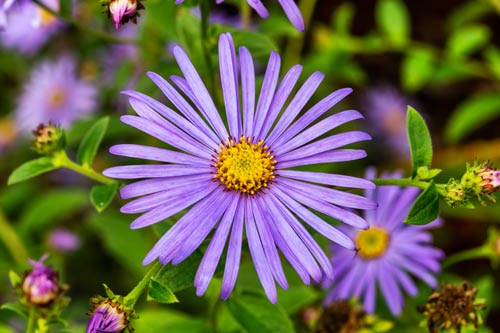
As a member of the daisy family, aster makes for a stunning and ethereal addition to any Spring or Summer bouquet. In recognition of its blooms' resemblance to stars, it earned the Greek name for 'star'.
It is believed that there are roughly 180 species of aster, with just the aromatic aster producing scent. They are famed for their wide range of purple tones as well as whites and softer pink varieties, all of which add an air of regality to any bouquet.
Aster flowers are popular as cut flowers and can be used to make wreaths and other arrangements for funerals, weddings and other occasions. You will most commonly spot this flower dotted in gardens and placed within homes due to its vibrancy and graceful appearance.
Fun Fact:In Greek mythology, asters symbolise power, faith, and wisdom, and were often placed on gods' altars.
Origin:Native to North and Central America, as well as parts of Eurasia.
Vase life:5-14 days
Colour Range:Purple, white, light pink and blue
Best occasion:Asters are September's assigned birth month flower, so they make the perfect bouquet for someone born in September.
Symbolism:Love, wisdom, patience, faith, elegance, and beauty are all symbols associated with asters. From nobility to friendship to purity, every colour has deep symbolism behind it.
Azalea - a shrub that makes a statement

Azalea flowers are a must-have for any flower arrangement.
In a spring garden, these shrubs make a spectacular statement. They also add a welcomed pop of colour to a celebratory bouquet. Azalea are beautiful, bright and fragrant flowers that work well with softer blooms such as white roses and lilies, or with yellow flowers like freesia or daffodils.
Springtime is the perfect time to bring the outdoors in with a beautiful bouquet of azaleas. The vivid colours and soft textures of these flowers are sure to brighten your day and bring joy to your home.
So if you're looking for a way to spread some springtime cheer this season, consider gifting someone (or yourself!) with a bouquet of azaleas!
Origin:Azaleas are native to China, Japan and Korea.
Vase life:3-7 days
Colour Range:Yellow, pink, orange and red
Best occasion:These flowers are renowned for bringing good luck and positivity, making them the perfect gift for spreading joy.
Symbolism:Azaleas are a symbol of love and romance. They're often given as tokens of affection, and they represent strength and beauty.
Begonia - the bloom of gratitude

If large, flamboyant blooms are just what you’re after, begonias deliver just that. They’re one of the most popular flowers around, and for good reason: their distinctive, asymmetrical shape and large petals.
Begonias are one of the most popular perennials in the world and come in a plethora of rich and soft colours. They make excellent cut flowers, but they can also be grown as an evergreen foliage plant or as a houseplant.
So whether it's an anniversary celebration or simply because you want someone special to know how much they mean to you, give them the gift of beautiful and durable begonia flowers today!
Origin: Begonia flowers come from tropical climates, primarily grown in South America and Central America.
Vase life:Around 2 weeks, depending on the type of begonia flower you have and how you care for it.
Colour Range:Yellow, orange and red hues as well as white, pink and red species.
Best occasion:Because of the long association between begonias and lust/desire,these flowers would make a perfect anniversary gift.
Symbolism:Yellow begonias typically symbolise happiness, red variants represent romance and pink is known to represent longingness and desire.
Iris - the royal flower
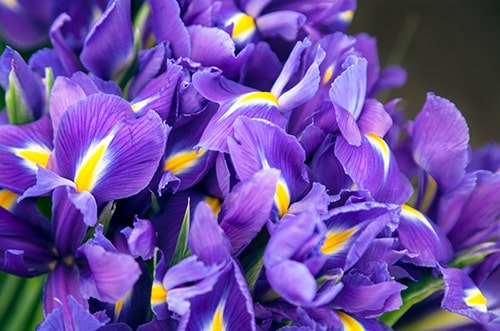
If you're looking for something truly unique and original, the iris flower is a great option.When you think of an iris flower, you might picture a sword-shaped petal with a deep purple colour and a unique aroma.
The iris is a flower that carries a rich history and deep meaning. It was used by the Greeks to symbolise the goddess of the rainbow, Iris, and it has since been associated with wisdom, courage, and beauty. This striking and alluring bloom is also associated with courage because its petals are often streaked with bright colours like red or yellow - the colours of fire and sunlight.
The iris flower is also often associated with royalty, but that doesn't mean it has to be reserved for special occasions! It can make an excellent addition to any home or office decor. Whether you want to add a touch of class or just want something beautiful on your desk, the iris flower is sure to do the trick!
Origin:There are roughly 280 species of iris in the world, with the majority said to be native to Europe and Asia.
Vase life:You can expect your iris flower arrangement to last up to a maximum of 7 days.
Colour Range: The iris flower comes in a wide variety of colours and types, ranging from pale shades of blue to bright orange.
Best occasion:There is no one occasion that the iris flower works well for due to the many meanings it carries. We recommend gifting this flower as a single or mixed arrangement for birthdays and wedding anniversaries.
Symbolism: Courage, wisdom, aspiration and wealth are all represented in the iris flower.
Orchid - hope, harmony and honour

Orchids are extremely unique, delicate and exotic flowers that are widely used to promote happiness and calmness in any environment. You may have seen orchids in spas and relaxing gardens, due to their ability to soothe the mind.
This perennial's flowers stand out from other prominent flowering plants due to their intricate features. Most orchids feature double or clusters of flowers, while some exhibit single flowers.
Orchid flowers come in many different colours and shapes: red orchids symbolise passion; yellow orchids represent friendship; orange orchids symbolise desire; blue orchids are symbols of hope and faithfulness; purple orchids are used as tokens of royalty; white represents innocence and purity; pink orchids symbolise love.
Origin:The orchid is Columbia’s national flower, and South America is said to have the highest number of this type of flower than any other continent.
Vase life:Cut orchids can last anywhere from 3-5 days, but well-cared-for potted orchids can last between 2-4 months.
Colour Range:You can get interesting tones and hues of orchids, some include white, yellow, red and bluer (the rarest colour!).
Best occasion:Due to their natural spiritual meaning and ability to promote harmony in any room,orchids make for a meaningful housewarming gift. They’re also popular for wedding table decor and bouquets.
Symbolism:The main representations of an orchid are fertility, refinement and beauty.
Peony - a regal romantic
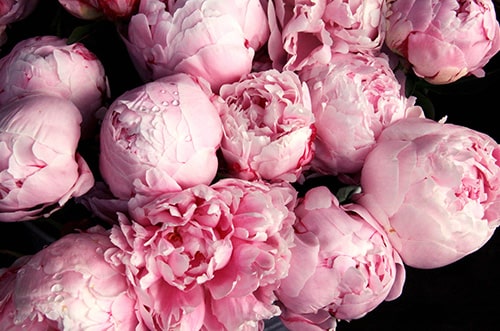
The peony flower is a timeless classic. Its voluptuous, royal beauty is perfect for any bouquet, especially when paired with other white flowers and greenery.
Peonies are one of the most beloved flowers in the world, and are particularly favoured as a Spring and Easter flower. Not only do they have a delightfully fresh scent that fills your home with springtime freshness, but they also add a regal touch to any room. Their blooms, which tend to be on the larger side, come in a variety of colours and shades, from soft pink to deep red. They can also be found in white and purple hues, but the blush pink is perhaps the most popular with customers.
The blooms of peonies can reach up to 10 inches wide, which makes them sure to capture the attention of anyone in the room!
Origin:The peony flower is native to both China and Japan.
Vase life:The beauty of a peony bloom can last around 5 days.
Colour Range:This flower can be found in both soft and vibrant colours including blush pink, white, red, orange and yellow.
Best occasion:An ideal occasion is a wedding, since peonies symbolise love and romance. A 12th wedding anniversary is also traditionally marked with them.
Symbolism:This flower is generally associated with love, happiness, wealth and romance.
Hydrangea - a classic charm
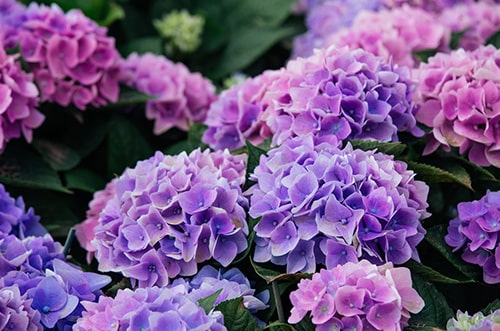
Hydrangea flowers are the perfect gift for summertime.It's a bouquet that promises to bring the outside in, as many flower lovers adore the many varieties of hydrangea!
With their big, beautiful blooms and classic colour palette, they're a classic choice for any bouquet. And with Hydrangea's large selection of varieties - ranging from bigleaf to mophead - you can find the perfect one for any occasion.
Bigleaf hydrangeas are characterised by their large, rounded flower heads and vibrant leaves. Mophead hydrangeas have smaller, more compact flowers that bloom on shorter stems than their bigleaf counterparts.
Whether you're looking for something simple and elegant or something more bold and vibrant, there's a hydrangea to suit your style!
If you’re on the hunt for a flower arrangement that conveys your love (without even saying a word), hydrangea arrangements will do just that. This beautiful bouquet pairs well with other soft-colored blooms like tulips and roses to create a romantic and elegant look that will make your loved ones' heart skip a beat.
Origin:Hydrangea's origins can be traced back to China and Japan, where it was originally used as a medicinal herb.
Vase life:The vase life of hydrangea is approximately 10 days.
Colour Range:Hydrangeas come in a range of colours, including white, pink, blue, purple and red.
Best occasion:Hydrangea, the flower of fourth wedding anniversaries, is the perfect gift for your spouse to show them just how much you care.
Symbolism:The flower has several meanings: it can represent friendship, loyalty, and happiness. It can also represent triumph and victory in some cultures.
Sunflower - the staple of summer
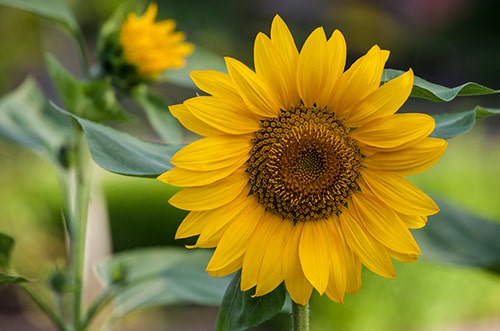
Nothing brightens someone's day more than a sunflower. With its gorgeous, brilliant height and petals and the way it seems to radiate light, it's no wonder that this flower is so beloved.
The sunflower has been long-regarded as a symbol of happiness and good fortune, and it's easy to see why. With their bright, cheerful faces and beautiful colours, sunflowers are a charming addition to any bouquet.
Moreover, this elegant flower has been a part of weddings for decades, but its popularity has skyrocketed in recent years. Many brides and grooms have selected sunflowers as part of their wedding, letting them play an integral part in creating a rustic, English country look.
So, if you're looking for flowers that will stand out in any room or vase, sunflowers are the way to go. They have an unbeatable combination of beauty, strength, and durability that will last for days without drooping.
| Fun Fact:One of the tallest sunflowers ever recorded was 30 feet tall and required scaffolding to stay upright! |
Origin:The sunflower plant is native to North America, where it grows wild in the prairies
Vase life:Sunflowers are known for their vase life -they can last up to two weeks without wilting.
Colour Range:You will find sunflowers in shades of mahogany, yellow, white, cream and gold.
Best occasion:Sunflowers are great for many situations. They can be used in bouquets, arrangements, or even just by themselves to brighten up your home or office.
Symbolism:As you may expect, sunflowers represent happiness and good fortune in many different countries.
Marigold - a dazzling delight

A marigold flower is a bold, vibrant burst of colour that lights up any garden or flower arrangement.
Named after the Virgin Mary, this flower is known for its bright folds of petals and crisp scent. It's one of the most popular flowers in the world due to its distinctive characteristics and beauty.
The two most popular types of marigolds are African (Tagetes erecta) and French (Tagetes patula). Both varieties are annuals, which means they grow from seed each year and die after one season. The plants can grow up to 24" tall and produce flowers in shades of yellow, orange, red, or white.
As with all flowers, the marigold has multiple symbolic meanings. On one hand, their fiery tones are said to represent optimism, positivity and happiness. But on the other hand, they carry much darker meanings. The marigold can symbolise grief and jealousy - they are traditionally placed upon graves throughout an annual festival in Mexico.
Origin:Marigolds were originally grown in Mexico, where they are associated with Dia de Muertos or Day of the Dead.
Vase life: Marigolds can last up to 7 days or more.
Colour Range:Marigolds are known for their rich colour, which ranges from yellow to orange to red.
Best occasion:Marigolds are a great choice for October birthdays, but they can also be gifted as sympathy flowers to spread positivity.
Symbolism:Energy, positivity, good fortune and compassion.
Rose - the flower for romance

When you’re searching for romantic flowers to send to a significant other, you’re sure to think of roses.
Roses are timeless, elegant, and bold - and every woman's favourite.The colour range of roses is endless, so you can choose a bouquet that perfectly matches your loved one's personality.
Roses are a familiar sight, with their characteristic scent and beautiful flower petals. They're known for their rich history - the rose has been associated with romance since ancient times. These delicate flowers have been used for centuries to celebrate love, friendship, and all the other things that make life beautiful.
Roses with long stems are hybrid tea rose types that are most commonly used by florists and sold as cut flowers. These gorgeous blooms come in almost every colour imaginable, from classic reds and pinks to more exotic purple shades.
So,when Valentine's day approaches, don’t hesitate to gift your other half with a dozen (or more) roses- this flower is always a hit!
| Fun Fact:It is estimated that the oldest living rose is 1,000 years old! Hildesheim Cathedral in Germany has it mounted on its wall. |
Origin:The rose is one of the oldest flowers, making its origin difficult to pinpoint. However, most species of rose are thought to grow in Asia.
Vase life:A standard cut rose can last up to 10 days, and preserved roses can last 21 days or even longer.
Colour Range:Imagine every colour in the rainbow, except black or blue. It’s common for florists to produce multi-coloured or blue-hued roses using dye.
Best occasion:The rose is the definition of romance, by far! We suggest gifting a rose bouquet for any romantic occasion.
Anemone - the keeper of secrets
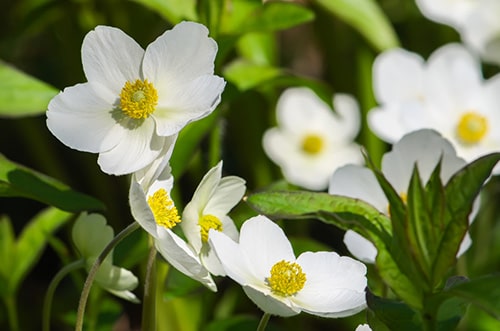
Looking for an impressive birthday bouquet or floral housewarming gift? Available in a wide range of colours, the showy anemone will immediately elevate any flower arrangement.
Far from the sinister, spiky creature of the sea, this flower is a graceful bloom packed with symbolism…
The anemone has a distinct role in many cultures around the world. In Greek mythology, it has romantic connotations and is connected to Aphrodite, the Goddess of Love. Meanwhile, in the East, the white variety is symbolic of bad luck and represents death. Two very different meanings!
As an early blossoming flower, the anemone is often connected to the arrival of spring.Its fragility is highlighted in the nickname ‘windflower’, referencing the ability of the wind to pick off its delicate petals.
Perfectly balancing elegance and impact, we love the anemone’s graceful silhouette and vibrant colour palette. Its dainty petals and eye-catching dark centre look great with other spring flowering bulbs, such as tulips, daffodils, and lily of the valley.
| Fun Fact:A flower fit for a fairy - in English and Irish folktales, it was believed that fairies would sleep within the petals of the anemone as they closed at night. It’s important to note that no dainty wings are harmed in the process of arranging this gorgeous bloom! |
Origin:Anemone flowers are native to Japan.
Vase life:If harvested as soon as they open, the anemone can last up to 10 days in a vase.
Colour range:This bright bloom comes in shades of white, pink, red, blue, purple, and yellow.
Best occasion:The anemone is a highly decorative flower and works well in a variety of seasonal bouquets and vase arrangements. Gift a stylish design to celebrate a birthday or to brighten up a Tuesday afternoon - the options are endless!
Symbolism:A complex flower, the anemone symbolises anticipation, mutual respect, bad luck, death, forsaken love, and coming fortune.
Cornflower - a painter's pride and joy
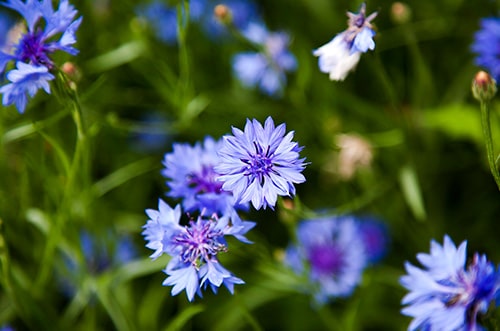
With its beautiful, almost sapphire shade of blue, the cornflower is the crown jewel of many flower arrangements.
Cornflowers are an eye-catching ornamental plant with a history of symbolism. In Ancient Egypt, the flower was likened to the blue lotus and represented life and fertility. As a symbol of fidelity and tenderness, it frequently appeared in Renaissance paintings to decorate the garments of goddesses.
The cornflower is also known as the Bachelor’s Button, a nickname that arose from the old practice of men wearing a cornflower in their buttonholes as an indication of love or courting.
Originating in the cornfields of Southern Europe, the cornflower’s vibrant energy and attractive colour transports us with its rich hues - reminiscent of the countryside, sunny blue skies, and the gentle breeze of summer.
As cut flowers, their deep colour and intricate detailing can elevate a classic bouquet or add a unique twist to a wedding bouquet.
Origin:The cornflower is native to Europe.
Vase life: Cornflowers can last up to a week or even longer with the help of floral preservatives.
Colour range:Cornflowers are known for their brilliant shade of blue, although white, red, pink, and purple varieties are also available.
Best occasion:In the language of flowers, cornflowers represent positive hope for the future and are a great way to say ‘congratulations’.
Symbolism:Remembrance, anticipation, love, and prosperity.
Cosmos - a flower of the faeries
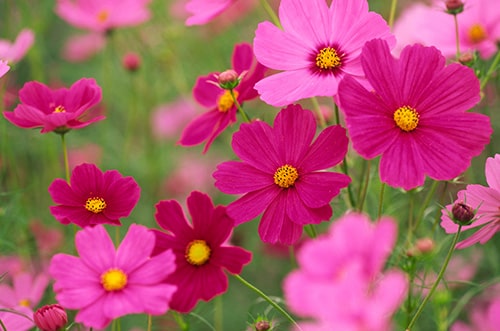
If you’re a lover of the daisy, then you’ll certainly be a fan of its bold and beautiful cousin! With lacy leaves, broad blooms, and perfectly symmetrical petals, the cosmos flower will add texture and variation to your bouquet.
With a distinctive, sugary fragrance and varied colour range, sunny meadows filled with cosmos flowers are as delightful and intriguing as an assortment of sweets.
Due to its uniform shape and upright structure, the cosmos is a versatile companion for any number of flower combinations. We love pairing this charming bloom with varieties of a similar size, like dahlias and marigolds, to create a sunny floral arrangement for birthdays and other celebrations.
| Fun Fact:A flower of folklore, the cosmos is said to attract faeries to your garden - so keep an eye out for tiny wings and a twinkling trail of dust next time you’re outside! |
Origin:Like many warm weather annuals, the cosmos is native to Mexico and South America.
Vase life:As a cut bloom, this flower can last between 5 and 7 days in a vase.
Colour range:From the purest of whites to the deepest of browns - along with vibrant pinks, crimsons, and oranges - there are various colours to choose from!
Best occasion:As the cosmos flower is linked to the astrological sign of Libra, why not send a birthday bouquet to a loved one born between September 23rd and October 22nd?
Symbolism:Order, harmony, beauty, kindness, and infinity.
Craspedia - the beloved billy button

A close cousin of the daisy and sunflower, Craspedia is a jolly little flower that gives a new lease of life to meadows, back gardens, and floral displays.
Popular for its sturdy stalks and fuzzy, button-shaped flower heads, Craspedia is extremely versatile and unique. It can be used in a cut or dried form, retaining its colour and form for at least a week.
We love this flower for its ability to add zest to any arrangement - you can even tint the flower heads with various colours to create a bespoke look.
Over the years, Craspedia has become a popular choice at weddings and can be incorporated into multiple floral decorations. As an intriguing and not entirely feminine aesthetic, this flower is perfect for both men’s boutonniere designs and bridal party bouquets.
As a more modern symbolism of love, affection, and admiration,Craspedia is perfect for a romantic setting, such as a wedding or even as an anniversary bouquet.
| Fun Fact:Strike a pose! As well as being popular in floriculture, Craspedia is loved in the art and design world and is commonly featured in paintings, photographs, and even textiles. |
Origin:With the ability to grow in several habitats, Craspedia is native to Australia and New Zealand.
Vase life:A sought-after cut flower, Craspedia can last up to 7 days.
Colour range:Craspedia naturally blossoms in shades of yellow.
Best occasion:The flower’s connection to good health and recovery makes it the perfect choice for a cheerful get well soon bouquet. In fact, its positive connotations and sunny colouring are great for any number of celebrations, from birthdays to Father’s Day and wedding anniversaries.
Symbolism:Good health.
Delphinium - vibrant and vivacious
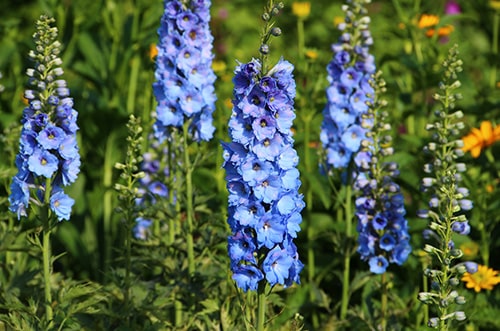
With a commanding presence and vibrant colouring, the delphinium will stand tall in any flower arrangement. Easily identified by its long green stalk and abundance of single or double flower stems, its charming presence can be found in the grounds of stately homes and quaint cottages.
There are numerous varieties, shades, and forms - each with its own symbolism. A blue delphinium is generally representative of dignity and grace but can also be linked to remembrance. In comparison, a pink delphinium is often used to celebrate new life and birth.
The name delphinium was derived from the Greek word ‘delphis’, meaning dolphin, due to the individual flower forms being reminiscent of this friendly mammal’s elegant outline.
Boasting the understated beauty of summer gardens and being one of the official birth flowers of July, the delphinium signifies all things sunny, warm, and joyous.
Whether you’re searching for the perfect birthday bouquet, token of affection, or a celebratory gift, the delphinium is the perfect centrepiece for any floral arrangement.
| Fun Fact:According to Greek mythology, the Delphinium flower is said to have blossomed from the blood of the Greek god and Trojan war hero Aias. |
Origin:The delphinium is native to the Northern Hemisphere, thriving in the cool and moist climate of the African tropics.
Vase life:At best, the delphinium can last between 5 and 8 days.
Colour range:With an array of rich indigos, purples, pretty pinks, and pure whites, this species has a range of eye-catching shades.
Best occasion:An extremely versatile flower, the delphinium is perfect for any celebration - from birthdays to anniversaries and even Valentine’s Day.
Symbolism:Cheerfulness, protection, joy, and goodwill.
Eucalyptus - the protector
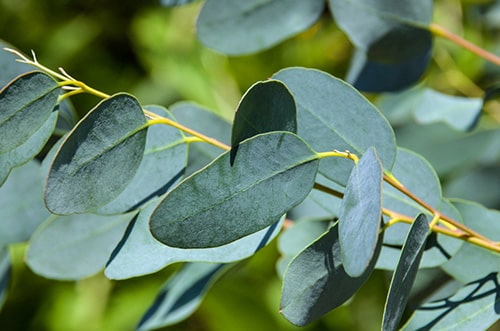
Offering a fresh variety of hues and shapes, the eucalyptus plant adds dimension and a burst of greenery to bouquets, flower arrangements, and table decor.
Particularly popular at weddings, its aromatic, slender leaves, and soft colour palette work as both a decorative feature and tasteful backdrop. Commonly paired with more romantic blooms, such as peonies, orchids, and roses, it works well with just about any style of arrangement - from classic and elegant to boho and modern.
Despite being seen as a tasty treat by koalas, this ornamental foliage is loved around the world for its energising and healing properties. Originally used as part of an Australian Aboriginal ceremony - in which the leaves were burned to purify and negate negative energy - the eucalyptus is considered a sacred plant.
Its calming scent has been described as a heavenly blend of rich, earthy tones and reinvigorating citrus or honey notes - making it the perfect addition to candles, baths, and body products.
| Fun Fact:With several health benefits, many people hang fresh eucalyptus in their shower - helping to reduce anxiety and ease congestion. |
Origin:The eucalyptus plant is native to Australia.
Vase life:Eucalyptus stems will last between 3 and 8 weeks in water.
Colour range:Eucalyptus is close to a sage-green in colour, with undertones of blue, silver, and grey.
Best occasion:Eucalyptus is a popular addition to wedding flowers, adding a burst of fresh foliage to any style of arrangement or bouquet.
Symbolism:Strength, protection, and abundance.
Forget-Me-Not - the symbol of eternal love

Also known as Scorpion Grass, the forget-me-not has a history of deep symbolism. Once the formal emblem of King Henry IV, this plant has evolved from a symbol of royalty to the official state flower of Alaska and Grandparent’s Day.
The forget-me-not is a delightful flower of springtime, making it the perfect gift for spring birthdays and weddings. Its delicate petals and pretty pastel tones can be spotted among the babbling brooks and rich greenery of woodlands and meadows.
A popular addition to bridal bouquets and remembrance blooms, the small, uniform clusters add intricate detailing and depth to many floral arrangements. Their perfect pop of blue is further enhanced by the use of evergreen foliage.
As a symbol of true and eternal love, the name originates from the old German tale of a knight who, in a fatal quest to retrieve the flower for his lover, whispers with his last breath, ‘forget me not!’. Be sure to keep this romantic message in mind for next Valentine’s Day!
| Fun Fact:The common woodland forget-me-not is edible and frequently used as a cake decoration. |
Origin:The forget-me-not is native to Europe, Asia, and North America.
Vase life:Once the leaves have been removed, the vase life of this flower is between 5 and 6 days.
Colour range:The most common shade of forget-me-not is a pale blue - however, they are also found in pink and white.
Best occasion:An incredibly unique flower, forget-me-nots are ideal for gifting on Valentine’s Day in a romantic bouquet or as a going-away present.
Symbolism:True and eternal love, devotion, fidelity, and remembrance.
Freesia - a dainty silhouette

A springtime sweetheart, the freesia is the picture of elegance. With the colour palette of precious gems and a refreshing, citrusy scent, you can see why the freesia flower is loved by so many around the world. Its long-lasting blossoms, elegant structure and upward-facing petals make it a favourite for displaying in a vase or gifting in bouquets.
The freesia has striking, funnel-shaped flowers and bilaterally symmetric blooms that have often been likened to the dainty silhouette of a dancer, hence the common nickname ‘ballerina’.
Named to honour friendship, the freesia has sentimental value and is the perfect gift to show your best friend just how much you love them! However, as with many types of flowers, each of the freesia’s various hues has a unique meaning.
‘Belleville’ is one of the most well-known varieties, with pure white flowers that symbolise innocence and purity. Hugely popular at weddings, this particular freesia is an ideal choice for flower girls.
A fiery combination of vivid red and lemon-yellow, the ‘Oberon’ variety certainly steals the show! It is also the most fragrant and the symbol of passionate love - perfect for sending as a romantic gesture.
| Fun Fact:The freesia flower has its very own festival! Every year, a magnificent display of hundreds of thousands of freesias can be seen on Hachijojima island in Japan. |
Origin:Belonging to the Iris family, the freesia flower is native to South Africa.
Vase life:Up to 3 weeks, if cut when still in bud.
Colour Range:Freesias bloom in an impressive spectrum of colour, from whites and creams through to reds, oranges, pinks, mauves and lavendars.
Best occasion:Freesias are traditionally gifted on the 7th wedding anniversary.
Symbolism:Lasting friendship, sweetness, innocence and trust.
Gardenia - peace and purity

Gardenias hold great cultural significance due to their colourful history. Whether it’s their association with paradise in Greek mythology or popularity during the Victorian era as style accessories, they have been featured in popular culture, the arts, and literature for centuries. Although traditionally seen as symbols of purity, there’s more to this flower than meets the eye! The gardenia also holds significance as a symbol of secret love and is often associated with the power of attraction.
While commonly used as a decoration at wedding ceremonies, this flower’s calming energy and association with peace and renewal make it a perfect housewarming gift or get-well-soon gesture.
| Fun Fact:The gardenia is the National Flower of Pakistan and a prominent feature of Pakistani wedding celebrations. |
Origin:The gardenia is indigenous to Africa, Asia, and Australia.
Vase life:The optimum vase life for gardenias is up to 3 days.
Colour range:The most common colour is white, with other varieties of red, pink, and pale yellow.
Best occasion:Known for their elegant petals and sweet fragrance, gardenias are a gorgeous choice for a wedding bouquet.
Symbolism:Purity, gentleness, love, trust, and joy.
Gladiolus - strength of character

Among the top best-selling florist flowers worldwide, it’s fair to say that we are big fans of the gorgeous gladiolus. As a cheerful and versatile flower, its uplifting presence elevates any bouquet - a gift for all occasions!
While there are plenty of other flowers that complement the gladiolus well, a colourful display of gladioluses, roses, irises, and lilies is our idea of heaven!
Connected to the Greek goddess of harvest and agriculture, the gladiolus transports us to the kaleidoscopic hues and joys of summer. Popular in gardens and contemporary floral arrangements, its flamboyant petals are sure to brighten up the home.
As a statement flower, the gladiolus is typically reserved for the most special of occasions, including Valentine’s Day and birthdays. It is also the traditional 40th anniversary flower.
Whereas a pink gladiolus represents a mother’s love and a fitting token of appreciation, a yellow gladiolus is the ultimate symbol of positivity and joy, so keep this in mind if you have a graduation coming up!
| Fun Fact:In the Victorian language of flowers, the sword-like gladiolus is symbolic of ‘piercing’ a lover’s heart. |
Origin:The gladiolus flower is native to South Africa and the Mediterranean.
Vase life:Up to a week.
Colour range:With over 250 species of gladiolus, pink, red, white, purple, yellow, orange, and green are the most common colours.
Best occasion:One of the birth flowers of August, the gladiolus makes a delightful summer birthday bouquet.
Symbolism:Strength, faithfulness, moral integrity, and remembrance.
Gypsophila - the wedding favourite
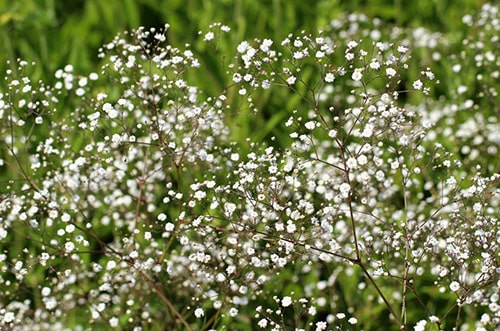
One of the most iconic wedding flowers, the timeless Gypsophila has certainly earned its place in the flower hall of fame.
This beautiful bloom is commonly used in traditional bridal decor, as well as Valentine’s Day gift arrangements. We’ve also seen Gypsophila in flower displays at baby showers- unsurprising given its nickname of Baby’s Breath!
Gypsophila typically blooms between the end of spring to early summer. Its light, sweet fragrance, intricate lacy detailing, and cloud-like texture make it a popular accent flower. The tiny delicate florets create a softening effect said to capture the elated feeling of love - how dreamy!
We would recommend combining your Gypsophila with statement flowers, such as roses and tulips. For more of a rustic look, why not display your Gypsophila in a mason jar?
If you’re a fan of bold bouquets or after a bespoke floral arrangement, then look no further than this pick. The white variety of these fluffy flowers can be dyed virtually any colour, for any style of floral arrangement.
| Fun Fact:A treat for the eyes and the taste buds - Gypsophila is used in many cuisines as an edible garnish on desserts and herbal cheese. |
Origin:Gypsophila is native to Europe, Asia, and North Africa.
Vase life:A popular accent or filler flower in bouquets or vases, Gypsophila can last at least a week.
Colour range:Gypsophila has an elegant colour range of white and pale pink.
Best occasion: A popular and versatile wedding flower, Gypsophila can be used in bridal bouquets, boutonnieres, flower crowns, and even corsages.
Symbolism:Innocent love, new beginnings, purity, and happiness.
Honeysuckle - the flower of pure happiness
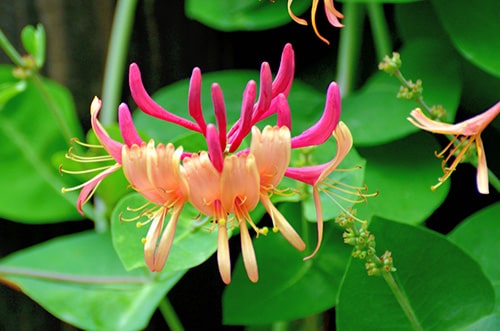
If you’re after a sweetly scented, joyous flower then the heavenly honeysuckle is the perfect bloom for you.
A staple of summer, the honeysuckle’s warm colour palette of peaches, pinks, and purples makes a beautiful addition to any bouquet. The perfect partner to lilacs and English roses, opt for this bell of the ball if you’re a fan of aromatic floral arrangements.
There are approximately 180 species of honeysuckle shrubs and vines, classified by their elongated tubular shape and intoxicating fragrance. They typically bloom during the warmer months, with their promising nectar attracting hummingbirds, bees, and other pollinators from afar.
As a symbol of pure happiness and all things sweet, the honeysuckle has been likened to the eternal flames of love. The trumpet-like flowers are even arranged in pairs, creating the picture of a lover's embrace. Many also believe that adding a honeysuckle to your home brings good luck and fortune.
| Fun Fact:Not just for decoration, the honeysuckle was once used to ensure pleasant dreams. Today, the flower is popular in the manufacture of herbal pillows. |
Origin:The honeysuckle is native to the Northern Hemisphere, primarily China, Europe, Asia, and North America.
Vase life:The honeysuckle stays in good condition for up to 10 days in a vase.
Colour range:This species has a wide spectrum of colours, from creamy whites, yellows, and peaches to more vibrant shades of pink, red, and purple.
Best occasion:Alongside the iconic rose, the honeysuckle is also the birth flower of June. Its sweet aroma and cheerful colouring are sure to brighten up anyone’s birthday.
Symbolism:Happiness, sweetness, nostalgia, and affection.
Jasmine - queen of the night

Star-like in appearance and widely recognised for its heavenly scent, the jasmine flower is immersed in myth and symbolism. Regarded as the epitome of beauty, romance, and femininity, the flower is often connected to the Greek goddess Aphrodite and the figure of Venus in Roman mythology.
A member of the olive family, there are around 200 different species of the plant - with a lifespan of 20 to 30 years in the wild. The flower is characterised by its dainty, bell-shaped blooms, alluring aroma, and pure colour, making it a popular choice for bridal bouquets.
Its significance varies from place to place. In Thailand, the flower is perceived as a celebration of motherhood whereas in parts of India it is often associated with intimacy and frequently features at weddings.
| Fun Fact:The jasmine flower is sometimes referred to as ‘Queen of the Night’ due to its associations with intimacy and tendency to bloom after sunset. |
Origin:Although difficult to pinpoint, the jasmine flower is believed to have originated in Iran.
Vase life:With proper care and handling, the expected vase life of jasmine flowers is around 5 days.
Colour range:Jasmine flowers are commonly a white or pale pink shade, although winter jasmine is a cheerful yellow colour.
Best occasion:A jasmine’s rich and sensual fragrance has often been associated with love, making it the perfect flower for romantic occasions such as anniversaries, weddings, and date nights.
Symbolism:Love, beauty, and sensuality.
Lavender - a flower of sweet dreams
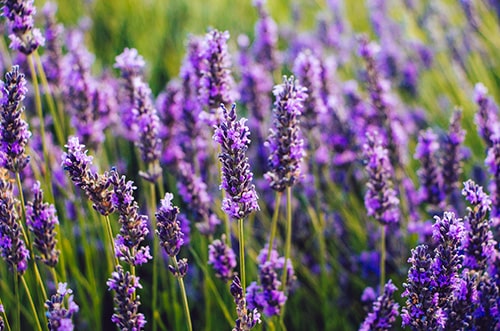
The pride of Provenance and English country gardens, we love lavender for its relaxing aroma and vibrant shade of purple.
Long considered a herb of love, this flower is truly a wonder. In the language of flowers, it is seen as a symbol of devotion and purity of heart. Lavender bouquets are a lovely gift to send to your significant other for a special occasion or just to say ‘I love you’!
If you want to keep the flowers looking fresh for longer, we would recommend opting for a dried flower arrangement.
Although a colour often associated with royalty, its recognisable purple tone has been adopted by many as a symbol of calm and serenity. Popped under your pillow or added to your bath oil, lavender isn’t just an ornamental plant and is commonly used for its refreshing fragrance and soothing properties.
| Fun Fact:Another royal family favourite, Queen Victoria was a huge fan of the lavender flower and regularly drank lavender-infused tea. |
Origin:Lavender is widely believed to have originated from the Mediterranean, the Middle East, and India.
Vase life:Cut lavender can last up to 10 days, but is best when dried.
Colour range:An iconic shade associated with tranquillity, the lavender flower is commonly a purple colour. It can also be found in white, pink, and blue-violet.
Best occasion:Lavender is a must-have for the home and a wonderful gift for any occasion.
Symbolism:Purity, devotion, serenity, grace and calmness.
Lilac - the spiritual bloom

With the start of spring comes new beginnings, the cheerful chirping of birds, and lilacs of course! Every year, these fragrant clusters of small-petalled flowers bring a joyful wash of purple and pink hues to our landscapes.
Not just for your grandmother’s garden, lilacs are a favourite in floral arrangements - adding height and a touch of elegance. In a vibrant seasonal bouquet, they are the perfect companions to bulb plants like daffodils and tulips, as well as peonies.
Off to a housewarming party but not sure what to bring? Linked to the coming of spring, a bunch of lilacs makes a great gift to say congratulations.
Known as ‘Queen of the Shrubs’ for its heady scent, magnificent colouring, and hardiness, lilacs certainly make an impression. Although widely recognised as symbolic of the joy of youth, each colour has its own unique meaning. A lighter shade of purple represents first love while magenta means intense passion. Both can be used to make a romantic statement to your significant other.
| Fun Fact:Luckily, lilacs are not toxic to you or your furry friends! In some cultures, the blooms are used as an ingredient in fried fritters! |
Origin:The lilac is native to Eastern Europe and Asia, but quickly became popular in America when it was brought over in the 17th century.
Vase life:Cut lilacs last between 3 and 4 days in a vase.
Colour range:Lilacs can be found in a variety of purple hues, pinks, creams, and whites
Best occasion:This enchanting flower is traditionally used to celebrate the 8th wedding anniversary.
Symbolism:First love, romance, spirituality, infatuation, and renewal.
Lily of the Valley - a fairytale romance
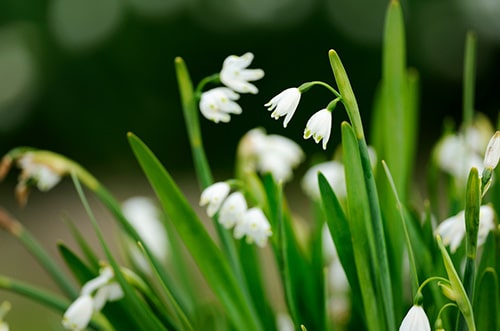
A sophisticated and delicately scented flower, lily of the valley is used in ceremonies, celebrations, and even perfume around the world. A member of the lily family, this flower has remained a classic and is frequently included in wedding bouquets as a symbol of purity and sweetness.
Intrinsically tied to the spring equinox and Germanic goddess Ostara, the dainty, bell-shaped blooms are widely celebrated in the month of May and make a beautiful addition to a spring bouquet. Traditionally, a bunch is gifted to a loved one on the 1st of May.
Once a staple for country estates or castle grounds, lily of the valley has become a household favourite - with the joyful, pure white petals bringing a touch of elegance to gardens, dining tables, and windowsills alike.
| Fun Fact:Lily of the valley was the late Queen Elizabeth II’s favourite flower and was featured in her coronation bouquet. |
Origin:Lily of the valley is native to parts of Eurasia and North America.
Vase life:In a small vase or container, lily of the valley can last up to a week when kept in cool conditions with medium light.
Colour range:Although commonly a white shade, there are many varieties that produce blooms with a pink tinge.
Best occasion:As the birth flower for May, lily of the valley makes a delightful birthday gift - alongside a card and some delicious chocolates.
Symbolism:Purity, youth, joy, sincerity, and rebirth.
Lotus - the sacred one

Emerging from the murky waters of lakes and ponds is the captivating beauty of the lotus flower. This unique, aquatic plant is a popular choice in floral arrangements for a variety of occasions - from birthdays and weddings to anniversaries and baby showers.
Sacred in cultures around the world and a source of artistic inspiration, this flower has been celebrated for centuries and frequently symbolises the Divine. A regular sight in ancient Egyptian hieroglyphics, the lotus was associated with rebirth, creativity, and the sun.
The lotus flower is also a famous symbol in Hinduism and Buddhism, representing enlightenment, growth, and spiritual awakening. The pink variety is known as Buddha’s earthly symbol and is the national flower of India.
Like many flowers, the red variety can be linked to passion and the heart. The yellow variety references openness and hospitality, making it the perfect present to bring to gatherings and housewarmings, or to display in your guest bedroom.
With its connection to water, deep spiritual meaning, and calming colour palette, the lotus flower is commonly referred to as the Flower of Life - what better gift to send to a loved one?!
Origin:The lotus flower has existed for millions of years and is primarily native to Australia and Southern Asia.
Vase life:Fresh lotus flowers can last between 2 and 3 days.
Colour range:Commonly white or pink, the lotus also comes in shades of purple, yellow, and blue.
Best occasion:Who needs a special event to send flowers? With its radiant colouring, one-of-a-kind blooms, and peaceful connotations, the lotus is a great gift all year round.
Symbolism:Strength, resilience, rebirth, spiritual awakening, and enlightenment.
Lupin - a gift of inner strength

As a statement flower, the lupin delivers on height and colour. If you’re looking for a touch of drama, this tall perennial makes a spectacular vase arrangement or centrepiece design. We would recommend pairing with ornamental grasses and other summer flowers, such as delphiniums and bearded irises.
Making brilliant cut flowers, their bold spires are packed with vibrant, pea-like blooms. Although famed for its blue and purple tones - hence the popular Bluebonnet variety, which is the state flower of Texas - there’s a lupin for every colour scheme imaginable. From muted creams and blush pinks to fiery oranges and reds, this showstopping bloom can be used to elevate any style of floral arrangement.
Loved for its exotic shape and honey-like scent, the lupin is the staple of English country gardens and deeply rooted in Native American myth. Its ability to thrive anywhere and transform barren landscapes into breathtaking views is closely linked to its relevance as a symbol of determination, new opportunities, and hope for the future.
Origin:A member of the legume family, lupins are native to the Mediterranean and the Americas.
Vase life:This flower will last up to 7 days in a vase.
Colour range:A truly majestic colour palette, lupins can be found in white, yellow, pink, red, blue, and purple.
Best occasion:Associated with positive energy and overall happiness in the language of flowers, the lupin is often sent as a gift to a loved one recovering from trauma or to wish good fortune.
Symbolism:Imagination, admiration, and inner strength.
Magnolia - a flower of femininity

With large, bowl-shaped blooms, a majestic colouring, and lightly fruity aroma, we believe that the magnolia flower is a must-have for special occasions.
As a group of flowering shrubs and trees, the magnolia’s pastel-toned, tough petals are different to the dainty and soft texture of other plants. A statement tree in the garden and a striking addition to floral arrangements, bouquets, and even corsages, few flowers can match the ornamental appeal of the magnolia.
The magnolia has been around for hundreds of years and has acquired a rich symbolism around the world. In Chinese culture, the flower is seen as a symbol of purity and nobility. In the ancient practice of feng shui,the ritual of planting a magnolia tree or shrub in your garden can encourage peace and tranquillity. So why not send a magnolia as a get-well-soon gesture or thoughtful gift to a loved one?
With most species blossoming during the spring, magnolias are often celebrated in seasonal festivals in the southern parts of the United States.
| Fun Fact:Magnolias are prehistoric! Fossil records show that the plant is at least 20 million years old. |
Origin:The magnolia tree is native to North and South America, East Asia, and the Himalayas.
Vase life:Magnolia flowers last for about a week.
Colour range:White, pink, purple, and yellow.
Best occasion:As a cultural symbol of womanhood, why not spoil your loved one with a fresh bouquet of magnolias on Mother’s Day?
Symbolism:With many different cultural meanings, the magnolia symbolises perseverance, beauty, purity, femininity, and nobility.
Monkshood - a bloom of myth and legend
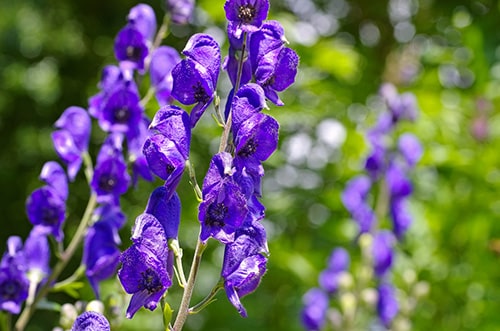
Among the pretty pastels and delicate blooms of late summer, you’ll find the vivid purple spires of monkshood.
Unlike the dainty daisy or charming sunflower, monkshood has a slightly more sinister history. During the Dark Ages, the flower was associated with the condition of ‘werewolfism’ and appears frequently in European folklore as an ingredient in witches’ brews and ointments.
Although famed for its toxic properties, having been featured in the works of Shakespeare, Keats, andHarry Potter,we love monkshood for its entrancing, gothic beauty and ability to add instant drama to bouquets.
It can grow to an impressive 4-feet tall, with hood-like blossoms that lend the flower a mystical aura. Monkshood’s highly pigmented tones look stunning in contemporary floral arrangements or can even be used to add a point of interest to bridal bouquets.
| Fun Fact:Also known as ‘Wolf’s Bane’, the juice from monkshood roots was once used in the tips of arrows for hunting wolves - so handle with caution and keep out of reach of children or pets! |
Origin:Although said to originate from the toxic saliva of the three-headed dog Cerberus, this perennial plant is actually from the mountainous regions of Europe and the Himalayas.
Vase life:Monkshood stays vibrant for up to 10 days.
Colour range:Yellow, blue, and purple.
Best occasion:Monkshood is ideal for more dramatic floral arrangements and late summer to autumn birthday gifts. It is also used to add depth to funeral wreaths.
Symbolism:In the language of flowers, Monkshood symbolises treachery, caution, and danger.
Nerine - an ethereal wonder
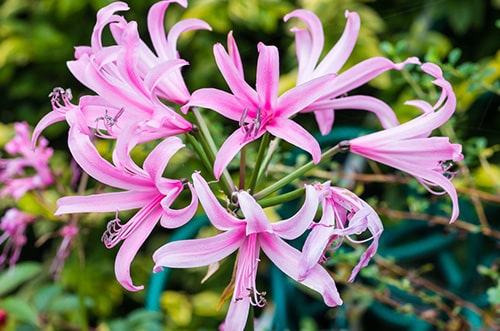
Also known as the ‘Guernsey Lily’ in the UK, the nerine is an extremely versatile flower. Characterised by shimmering petals, bright hues of pink, orange, and red, and a star-like form, this bloom is a beauty!
The nerine flowers in late summer and early autumn - generally between the months of August and October.
With its feminine appearance and elongated stems, the nerine is often used to add a touch of sparkle to tall vase displays. It also introduces a pop of colour to rustic cottage-garden or more contemporary bouquets. We recommend combining with other late bloomers, like dahlias, echinacea, and rudbeckia.
The name ‘Nerine’ is believed to be a reference to the 50 beautiful daughters of the sea-god Nereus - hence the flower’s almost ethereal quality and connection to prosperity. Much like the spellbinding sea nymphs of Greek mythology, the nerine is truly a mesmerising flower.
Origin:The nerine flower is native to the cape of South Africa.
Vase life:With the correct treatment, this flower can last between 12 and 14 days in a vase.
Colour range:Glistening whites, pinks, oranges, and reds.
Best occasion:The nerine makes an impressive present for any occasion but is often used as a sign of affection or celebration of love. Got a special date or anniversary coming up? With a romantic colour range and natural shimmer, there’s no need for added bows or sparkles!
Symbolism:Freedom, good fortune, union, free spirit, and love.
Nigella - the bloom of many names

Love-in-a-Mist, Devil-in-the-Bush, Hair of Venus… there are many names for the enchanting nigella.
A true gem of the flower world, this delicate old-fashioned bloom belongs to the buttercup family and is often seen in traditional cottage gardens. Prized for its captivating colour palette and unique, wispy foliage, the star-shaped petals add a pop of magic to bouquets, containers, and baskets. The seed pods can even be used in dried floral arrangements for added texture and volume.
If its entrancing beauty wasn’t enough to win your affection, the nigella is also deeply immersed in folklore. Shrouded in mystery, this flower is valued across many spiritual traditions for its magical qualities and used as an ingredient in love spells.
Miss Jekyll is one of the most popular nigella varieties, with its attractive, feathery flowers, and pastel-blue shade. If you prefer a more romantic arrangement, Persian Rose and Mulberry Rose offer a range of powder pink and fuschia red tones that perfectly complement roses and sweet peas.
Origin:The nigella flower is native to Southern Europe and the northern regions of Africa.
Vase life:Between 7 and 10 days.
Colour range:Flowers usually come in a range of blue tones, as well as white, pink, and lavender.
Best occasion:Whether you have a special occasion coming up or a date night to plan, why not impress your significant other with a spellbinding floral bouquet?
Symbolism:Harmony and love.
Phlox - the flower of harmony
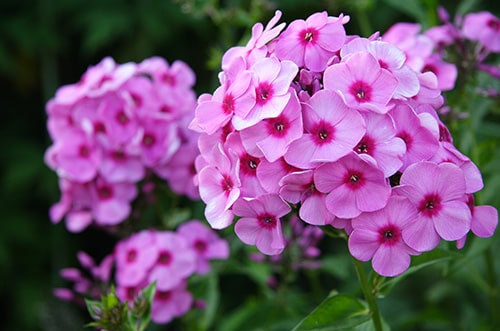
If you’re looking for the perfect summer bouquet, then the phlox is an ideal choice. With large, vibrant clusters of flowers and a warming, vanilla-like scent, this bloom is the prize of cottage gardens everywhere.
This low-maintenance flower blooms throughout the summer months and makes an excellent cut flower for various styles of arrangements. Combine with dahlias and lilies in bright shades for a cheerful bouquet. Alternatively, to create a whimsical or romantic feel, opt for more muted tones and blend with roses.
Like many plants symbolic of unity and peaceful connections, the phlox is often used in feng shui to encourage harmony in the home.
This flower is also deeply linked to love, promoting healthy relationships and harmonious connections. Throughout history, it has been used as a romantic gesture and even to indicate a marriage proposal - with those gorgeous blooms, who could say no?!
| Fun Fact:A flower with a fiery past - in Ancient Greece, the phlox was believed to have been created from the discarded torches of men journeying into the underworld, representing their bravery. |
Origin:The phlox plant is native to North America.
Vase life:Up to a week, if handled with care.
Colour range:Blue, purple, pink, magenta, red, and white.
Best occasion:With rich symbolism and a range of shades to explore, the phlox is great for just about any occasion - no matter how big or small. Said to boost productivity and encourage harmony in relationships, it is also a great office flower!
Symbolism:Harmony, partnership, compatibility, unity, and sweet dreams.
Poppy - a flower of rememberance
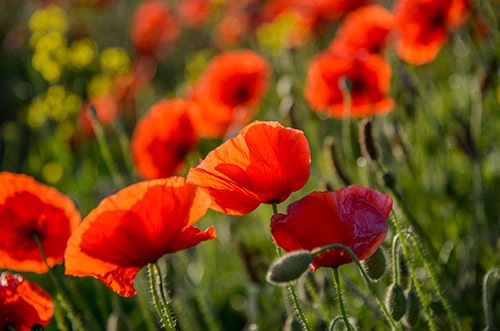
Whether you’re familiar with the traditional red remembrance poppy or the sunny orange hues of the California variety, this beautiful flower is celebrated by cultures around the world.
With bold, bright petals and deep symbolism, poppies are a meaningful addition to summer floral arrangements and wreaths. We’ve also seen this flower becoming an increasingly popular choice for bridal bouquets, adding a splash of colour and a playful twist.
Each variety has a distinct meaning, with the red poppy being synonymous in Europe and North America with Flanders Fields and the enduring message of remembrance and hope for a peaceful future. It is also symbolic of sleep, dreams, and imagination - just like in The Wizard of Oz!
Other colours - including pink, blue, and purple - are considered symbols of success, love, and luxury.
Known as ‘the flame flower’ or ‘cup of gold’, the California poppy grows in abundance throughout the state and has been awarded its own week of celebrations.
Origin:The poppy is native to the ancient land of Sumer (now modern-day Iraq and Kuwait).
Vase life:Although stunning cut flowers, poppies only last between 2 and 3 days in a vase.
Colour range:With 8 different varieties, the poppy covers every colour in the rainbow - from yellows, blues, and pinks to the more famous reds and oranges.
Best occasion:The poppy is the birth flower for August and the perfect gift for a summer birthday.
Symbolism:Remembrance, sleep, imagination, dreams, and success.
Queen Anne’s Lace - nature's woven wonder

Another flower with a captivating tale, Queen Anne’s lace is said to be named after the urban legend of Queen Anne of England and the ‘lace-like’ texture of its bloom.
Far from its slightly less glamorous past as a substitute for carrots, Queen Anne’s lace is now considered a beautiful wedding flower! When paired with feature flowers and vibrant greenery, it’s an elegant addition to bouquets, centrepieces, and boutonnieres. The wildflower is also great in rustic floral arrangements, for all occasions.
Loved for its intricately detailed, breathtaking bloom, it’s not surprising that Queen Anne’s lace is associated with beauty. In fact, women even used to add the flower to their baths in the hope of attracting love!
Also referred to as ‘bishop’s flower’, it now symbolises safety, sanctuary, and peace.
Origin:Though growing wildly today throughout North America, Queen Anne’s lace is actually native to Eurasia.
Vase life:Queen Anne’s lace can last between 3 and 5 days in water, or longer if preserved and used in a floral arrangement.
Colour range:Typically a muted yellow in colour, it can also be found in pastel pink and deep cranberry tones.
Best occasion:With its delicate white colouring, we love the use of Queen Anne’s lace as an accent flower in wedding bouquets and other floral decorations. In bloom between June and September, the flower is particularly popular at summer weddings.
Symbolism:Beauty, protection, safety, and peace.
Rudbeckia - the flower of resilience

Commonly referred to as Black-Eyed Susans,the rudbeckia is part of the Asteraceae family and a close sibling of sunflowers and daisies. Reminiscent of a hazy summer meadow, this flower is characterised by its long, sunny petals and black, seeded core.
A relatively large wildflower, the rudbeckia can reach up to 3-feet tall. The rudbeckia typically blooms from June to October and produces stunning flowers up to the early autumn months. The flower can be found anywhere, from the rolling hills of the North American countryside to sprouting on roadsides and in pavement cracks. This impressive ability to survive has led to its association with resilience, encouragement, and determination.
The rudbeckia’s spell-bounding appearance has been a frequent source of poetic inspiration, and its nickname is believed to have originated from an 18th-century poem about love and torment.
Combine with echinacea and darker foliage to make your bouquet pop or display in a vase to create a show-stopping centrepiece for a dining or coffee table.
| Fun Fact:Since 1918, the rudbeckia has been considered the official flower of Maryland. |
Origin:Rudbeckias are native to the prairies of North America.
Vase life:An excellent cut flower, the rudbeckia can last up to 2 weeks in a vase.
Colour range:The rudbeckia is available in a wide spectrum of colours, ranging from brighter yellows and oranges to more muted coppers, bronzes, and deep reds.
Best occasion:A symbol of encouragement and happiness, rudbeckias are the perfect flower for good luck or to brighten someone’s day.
Symbolism:Happiness, friendship, encouragement, and resilience.
Peace Lily - the air purifier

With silky flower-like spathes and glossy green, elongated leaves, this low-maintenance plant is the picture of grace and tranquillity.
Its official title is Spathiphyllum, which is derived from the Greek: ‘spath’ and ‘phil’, referencing the peace lily’s unique, spoon-shaped leaf. The plant’s annual blossoming is tied to its representation of hope.
As the name would suggest, this flower is the ultimate symbol of peace - with its spathes being likened to a white flag of surrender. It is also recognised for its unity with the surrounding environment, restoring balance and emanating positive energy.Perfect for a stressful work atmosphere or to bring harmony to the home.
A popular house and office plant, the radiant peace lily is easy to care for and does not have much of a fragrance. With the ability to remove toxins and purify the air, along with its refreshing colour palette, this flower is favoured in feng shui and brings a wash of calm to any space.
| Fun Fact:As well as its connection to a woman’s emotions, the peace lily is a Christian emblem of virtue and is linked to the Virgin Mary’s purity. |
Origin:Native to the tropical regions of the Americas and Southeastern Asia, the peace lily was originally discovered in the Columbian jungle.
Vase life:One of the most classic houseplants, the peace lily can last up to 6 weeks in water.
Colour range:Peace lilies can be classified by their white flowers and dark green leaves.
Best occasion:This plant is often used to express sympathy and is commonly included in funeral flower arrangements.
Symbolism:Peace, innocence, purity, healing, and hope.
Snapdragon - a force to be reckoned with
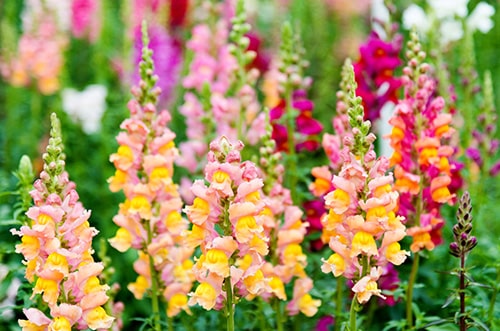
The ultimate symbol of grace and strength, the snapdragon is characterised by its slender stalk, snout-like shape and bright colouring. These short-lived perennial plants have a captivating bloom and an even more intriguing symbolism.
With their unique appearance and delightful, fruity scent that intensifies at night, these flowers appear otherworldly. There are many popular varieties of snapdragon, each with a name that takes you back to the magic of fairy tales and the stage. For instance, the Madame Butterfly is identifiable by its large double blooms whereas the Black Prince has a deep purple tone.
Never mind ring a ring o’ roses - this flower has been featured throughout European folklore as a protective charm against witchcraft and ageing. Snapdragons are also associated with deception and were historically thought to cloak women from unwelcome affections.
The snapdragon is a popular choice for adding a touch of drama and height to flower arrangements,transforming a classic bouquet into a statement piece. This flower is a great ornamental plant and works well when combined with pansies and violas in a mixed display.
| Fun Fact:The flowers of the snapdragon plant can open and shut like the mouth of a dragon - hence its name. |
Origin:The snapdragon originates from the west of North America and the western Mediterranean region.
Vase life:Snapdragons are the perfect choice for bouquets and can last for up to 2 weeks.
Colour range:White, yellow, orange, red, pink or, in some cases, lavender.
Best occasion:The snapdragon’s unique appearance and overall symbolism make it an incredibly versatile flower and perfect for a heartfelt token of affection.
Symbolism:Strength, grace, passion, and virtue.
Sweet Pea - summer's sweetheart
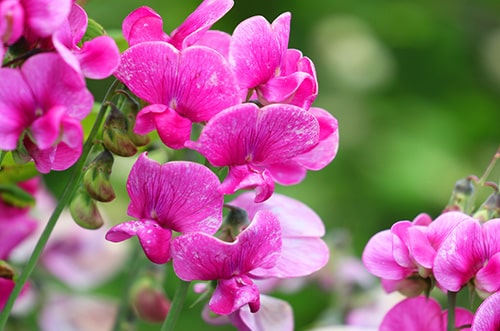
With its fluorescent colour palette and candy-like perfume, how can we resist the charm of the sweet pea? A firm favourite, this flower has been the delight of flower shops, spring weddings, and country gardens for years.
As a climbing plant, this flower is easy to cultivate and comes in a wide variety of colours. Its upward growth and versatility make it ideal for numerous floral arrangements, from pretty vase displays for dressers to more dramatic designs.
Much like its darling appearance, the many varieties of sweet pea have endearing names. These can be distinguished by their varying fragrance strengths and colour pattern. ‘Prima Ballerina’ is characterised by its delicate palette of pink and lilac; ‘Strawberry Sundae’ is a mouth-watering blend of rose, pastel pink and cream; ‘Apricot Sprite’ is an electric coral shade - to name a few!
| Fun Fact:In French culture, the sweet pea is regarded as a good omen and often given to a bride for luck on her wedding day and in marriage. |
Origin:Although considered quintessentially British, sweet peas are native to the sunnier climates of Southern Italy, Sicily, and Cyprus.
Vase life:Up to 5 days.
Colour range:With one of the widest colour ranges, this flower comes in shades of white, pink, coral, red, violet, and blue.
Best occasion:One of April’s birth flowers and one of the most quaint blossoms, the sweet pea is a popular choice for spring birthdays and weddings.
Symbolism:Bliss, good wishes, gratitude, friendship, and kindness.
Tulip - the Dutch darling

With their symmetrical shape and striking shades, the tulip is loved by many around the world. This plant flowers in spring and is associated with rebirth and new beginnings. If you want to give your home a fresh look and add a new lease of life, the tulip is the flower for you!
With plenty of tulip varieties to explore, there’s a colour for every occasion and individual taste. So, whether you’re a lover of all things bold or prefer more of a muted palette, you can be sure to find the perfect flower for you or your loved one.
Each tulip colour has its own meaning and can be used to convey different messages. White tulips are linked to purity and respect and are often incorporated into religious ceremonies, like a baptism or bar mitzvah. Yellow tulips are representative of happiness and prosperity while red and pink tulips have romantic connotations.
Although a universally popular plant, Holland has become closely associated with tulips - where each spring, the landscape is transformed into a rainbow of blossoming flowers.
If you’re searching for the perfect gift for your girlfriend, then look no further! A single tulip is often seen as the ultimate expression of love and affection.
Origin:The tulip was originally discovered in the mountains of Kazakhstan.
Vase life:Tulips can typically last up to 12 days in a vase, as long as they are well watered.
Colour range:Renowned for their bright colours, tulips can be found in a range of shades - red, pink, orange and yellow.
Best occasion:This classic flower makes a great year-round gift for family and friends, whether for Mother’s Day or to celebrate a loved one’s birthday. They are also the flower typically used to mark the 11th wedding anniversary.
Symbolism:Hope, perfect love, rebirth and charity.
Tuberose - bridal beauty
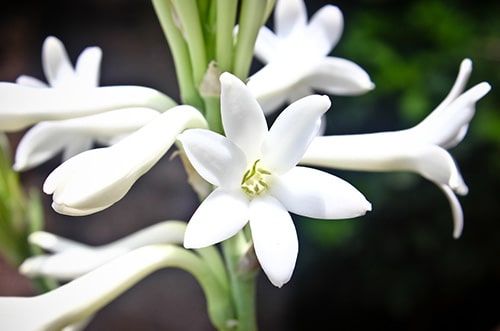
A deeply sensual flower, the tuberose is known for its intense perfume and delicate star-shaped blooms. If you have a romantic occasion coming up or want to impress your significant other, then a tuberose bouquet is the perfect gift.
The tuberose is characterised by a tall stalk with clusters of waxy flowers that bloom at night, with single and double-flowering types. Picture warm summer evenings filled with a rich honey-jasmine scent - heaven!
‘The Pearl’ is one of the most well-known varieties, with exquisite, creamy double flowers. As its name would suggest, this flower is particularly captivating and a popular choice for bridal bouquets. ‘The Pink Sapphire’ is another favourite, with beautiful, rose pink blooms perfect for summer floral arrangements.
| Fun Fact:A forbidden flower! Victorians believed that the bewitching scent of the tuberose was overwhelmingly erotic and young women and girls were forbidden from visiting a tuberose field. |
Origin:The tuberose flower is native to Mexico.
Vase life:Between 7 and 10 days.
Colour range:White and pastel pink are the most common colours - however, the tuberose can also be found in orange, purple and yellow.
Best occasion:The multiple meanings of the tuberose make it a particularly versatile flower and, due to its sturdiness and long-lasting scent, it can be used in a variety of arrangements. The classic cream shade is a staple at weddings while the intensity of the pink shade is ideal for a date night.
Symbolism:Elegance, passion, lust and attraction.
Tiger Lily - fierce and fragrant

Take a walk on the wild side with the show-stopping tiger lily. Rich in colour and rich in meaning, this flower is the ultimate symbol of confidence and prosperity.
The loudest member of the lily family, the tiger lily can grow up to 6 feet tall and typically blooms during the early summer months. Its tropical colour palette and fresh, floral scent are reminiscent of balmy days and vibrant landscapes - perfect for a flamboyant summer bouquet. Long used for ornamental purposes, this flower certainly delivers on the wow factor - instantly brightening and elevating any style of arrangement.
Connected to wealth and positivity, the tiger lily is often used as a sign of accomplishment and makes a great gift for housewarmings, graduations or promotions.
| Fun Fact:Flowers are frequently tied to myth and legend and the tiger lily is no exception. Some people say that smelling the fragrant blooms will give you freckles! |
Origin:The tiger lily is indigenous to parts of Asia, specifically China, Japan, Korea and eastern Russia.
Vase life:When cut, this flower can last up to 2 weeks.
Colour range:Tiger lilies are famed for their vivid orange blooms speckled with black. They are also available in shades of white, cream, yellow, pink, and red.
Best occasion:A true celebration, the tiger lily is the perfect flower to congratulate someone.
Symbolism:Wealth, positivity, pride and prosperity.
Veronica - the flower of loyality
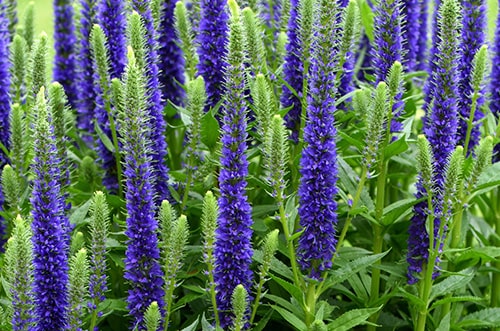
We love a classic cottage garden flower, and the Veronica is no exception! Characterised by its attractive spires of calming blue, pink and purple shades, this bloom is a staple of summer and requires minimal care.
A close relative to the snapdragon and foxglove, the Veronica plant’s elongated shape and multiple florets add vertical interest and texture. It is an ideal accent flower for seasonal bouquets and show-stopping centrepieces, for numerous occasions.
Famed for its dreamy blue colouring, Goodness Grows and Sunny Border Blue are among the most popular varieties.
Nicknamed ‘Speedwell’ for its medicinal qualities, the Veronica is a particularly tough flower and an emblem of enduring beauty. Its connection to Christianity and, more specifically, Saint Veronica has earnt it a place in symbolic gardens and led to its association with healing, protection and recovery. This deep symbolism has made the delicate bloom a popular choice for get well soon bouquets.
| Fun Fact:Not just for show, the Veronica flower was regarded as a miracle healing herb in Ancient Rome. Today, some cultures still dry the herb to use as a remedy for sore throats. |
Origin:With the ability to endure harsh conditions, the Veronica flower has origins in Europe and East Asia.
Vase life:The expected vase life of the Veronica is a minimum of 5 days. Keep in cold conditions to prevent petal loss.
Colour range:Blue, purple, pink and white.
Best occasion:Signifying fidelity and love, the Veronica is a popular summer wedding flower.
Symbolism:Loyalty, healing, devotion and fidelity.
Waxflower - pretty in pink
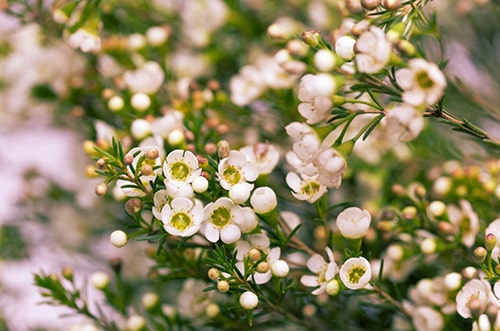
We love using the evergreen waxflower as a filler in floral arrangements - its delicate blossoms and vibrant foliage are often used to enhance statement flowers, such as pink roses and peonies. The woody shrubs help to add depth and lend the bouquet or centrepiece more of a rustic aesthetic.
Although not the most fragrant of flowers, the waxy petals give off a refreshing citrus scent - perfect for a guest bedroom or even an office space. If you’re not such a fan of the more intensely perfumed floral arrangements, then the waxflower is the bloom for you!
There are numerous types of waxflower. Named after the Australian town, Geraldton Wax is the most common, with long-lasting powder pink clusters and a striking dark centre. The large waxflower produces the biggest blooms and can grow up to 8 feet tall, whereas the Brevifolium variety is one of the smallest and most fragrant.
The waxflower’s most popular shades of white and soft pink are commonly used for detailing in romantic and boho bridal bouquets. Its dainty, flexible form is also perfect for table and cake decorations.
Origin:The waxflower is native to Western Australia, where it was given its botanical name Chamelaucium.
Vase life:An excellent cut flower, it can last up to 3 weeks.
Colour range:White, pink, purple and red.
Best occasion:As a symbol of long-lasting love, the waxflower is a favourite for wedding bouquets and other floral decorations.
Symbolism:Good fortune, happiness, long-lasting love and new beginnings.
Wisteria - the language of love
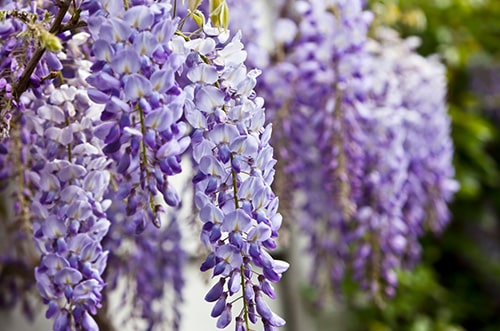
A cascading waterfall of purple blooms - it could only be wisteria!
Blooming in mid-spring, this spectacular floral display is truly a feast for the eyes. Although controversial for its invasive growing habits, wisteria is a popular ornamental plant.
With showy flowers and a scent that ranges from sweet to musky, it adds drama and volume to floral arrangements. The wisteria boasts a sweeping silhouette, standing alone in any vase display. We also love the breathtaking elegance of combining this statement flower with lilacs, peonies or roses.
Unsurprisingly, wisteria has a deep cultural significance around the world. In Korean folklore, the flower is linked to a tale of twin sisters who died of heartbreak and transformed into the beautiful wisteria vine - how romantic!
Wisteria has universal appeal, embellishing the arbours and arches of English country estates and the walls of quaint thatched cottages alike. Among the various types of wisteria, the Asian varieties are the most popular for their stunning flowers and appealing fragrance.
| Fun Fact:Wisteria actually belongs to the legume family. However, unlike the tasty pea, we wouldn’t recommend eating the flower as it is highly toxic! |
Origin:Native to Asia and North America, wisteria is widely cultivated around the world.
Vase life:The delicate blooms tend to last up to a week before beginning to droop.
Colour range:Wisteria ranges from softer shades of white and pastel pink to lavender-blue, lilac and mauve.
Best occasion:A truly romantic flower, wisteria is perfect for declarations of love and adds a touch of springtime elegance to wedding decorations.
Symbolism:Romance, devotion, success, good luck and longevity.
Bouvardia - petals of passion

Ranging from 1 to 4 feet in height, theBouvardiais a member of the Rubiaceae family and a close relative of the gardenia. With its delightful night-time fragrance and showy, trumpet-shaped flowers in a variety of eye-catching shades, the bouvardia is the picture of positivity.
From summer garden beds to exquisite wedding arrangements, the bouvardia is prized as a cut or ornamental flower. One of our personal favourites, we love the decorative pop of colour that the bouvardia brings to floral bouquets and vases - not to mention its long-lasting blooms!
Bouvardia ‘ternifolia’, also known as the Firecracker Bush, is a fierce little flower and one of the most popular varieties. Its fluorescent shade of red adds design interest and, dare we say, a touch of sass to home and cottage gardens alike.
Symbolic of enthusiasm, passion and the joys of living, the bouvardia is a magnificent celebration of life.
Available in a multitude of colours, each variety has a unique meaning that can be used to mark specific milestones and special occasions.
While the red bouvardia makes a great gift for more romantic events,the yellow bloom is symbolic of happiness and can be given to friends and work colleagues to offer well wishes.If you have a first date coming up, why not bring along a bunch of pastel pink bouvardia flowers?
Origin:The bouvardia flower is native to tropical parts of the Americas, including Mexico.
Vase life:A welcome addition to many floral arrangements, the bouvardia has a vase life of 2 to 3 weeks.
Colour range:Pink, white, peach, cream, green, red and lilac.
Best occasion:An extremely versatile bloom, the bouvardia can be combined with a wide variety of flowers for numerous celebrations, from birthdays to anniversaries.
Symbolism:Enthusiasm, passion, appreciation.
Clematis - a delicate wall-climber
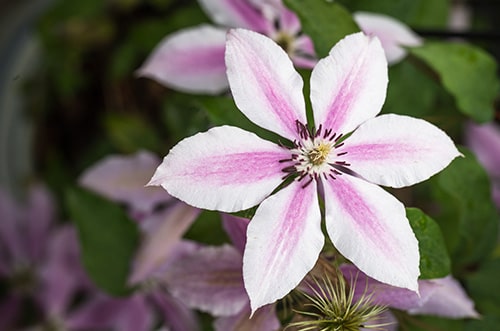
Known as the ‘Queen of the Vines’ for its show-stopping, vibrant blooms and unique form, it’s easy to see why the clematis is such a potent symbol of joy and good fortune.
With two blooming periods, the clematis has spring and summer-flowering varieties.
An impressive ornamental flower, the more popular clematis varieties feature striped, multicoloured, or larger than usual petals. Combine with tulips or bleeding hearts to create a unique floral arrangement.
The blooming beauty of country roads and pathways in the height of summer, this flowering vine carries the meaning of ‘a traveller’s joy’ and is commonly used across parts of Europe and Asia to wish people well on their journeys.
This significance has evolved to also represent the more metaphorical celebration of those embarking on a new career. So, if you’re attending a graduation party or know of someone who has recently got a new job, a bouquet of clematis flowers is a great way to say ‘congratulations and good luck!’.
| Fun Fact:In the Victorian language of flowers, the clematis was associated with cleverness and mental agility as a result of its agile and solution-based growing habits. |
Origin:The clematis flower is native to China, Japan, Europe and North America.
Vase life:A minimum of 10 days.
Colour range:Brilliant shades of purple, pink, blue white and red.
Best occasion:The clematis is perfect for celebrating those embarking on an exciting journey, whether that’s a new house or career.
Symbolism:Ambition, travel, wisdom, good luck, joy and ingenuity.
Dianthus - a spray of tickled 'pinks'
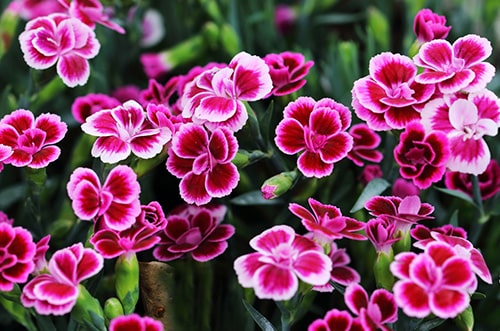
A treasure of the flower world, the dianthus has long been associated with the gods and divinity. In Ancient Rome, this flower was linked to the mighty sky-god Jupiter and was included in ceremonial wreaths, garlands and crowns.
If that’s not impressive enough,this delicately fringed bloom has been cultivated for hundreds of years- sprinkling a touch of botanical joy from Ancient Greece and Rome to the gardens of Monticello! Its versatility and ease of care make it a popular choice as a cut flower, bloogypp ming from early spring into the summer months.
With a warm, slightly spiced scent and an abundance of beautiful shades, the dianthus is a vibrant symbol of love and is commonly used in wedding floral designs as a filler or focus flower. We particularly love the combination of the dianthus, roses and verbena in a colourful and romantic arrangement.
Featured throughout art and literature, the flamboyant dianthus flower looks as though it’s jumped right out of a painting.
| Fun Fact:Cast away all your troubles. In Japan, smelling the fragrant dianthus flower and letting it blow away is said to bring good fortune and a positive future. |
Origin:With around 300 species, the dianthus flower is native to parts of Southern Europe and Asia.
Vase life:Up to 3 weeks.
Colour range:White, pink, red and purple.
Best occasion:Forget about jewellery or over-priced perfume, the dianthus is the perfect gift to show someone how much you care.
Symbolism:Love, affection, gratitude and admiration.
Forsythia - the flower that announces spring

Delight the senses with the delightful forsythia, characterised by bright yellow blossoms and sweet, honey-like perfume. If you’re a fan of the oh-so-popular daffodil, then you’re going to absolutely love this flower!
A sign of sunnier days and new beginnings, the warm tones and cheerful appearance of this flowering shrub have come to be associated with the joys of spring.
Unsurprisingly,‘Goldilocks’ is one of the most popular varieties- loved for its compact shape and rich shade of golden-yellow that can be likened to the luscious locks of this well-known fairytale character!
The forsythia is a perfect focus flower for larger arrangements, pairing well with tulips, purple wisteria and iris blooms.
Origin:Species of forsythia are native to parts of Eastern Asia and South East Europe.
Vase life:The vase life of the forsythia varies between 4 and 10 days.
Colour range:The forsythia is characterised by its bright yellow blossoms.
Best occasion:A beautiful alternative to the classic rose or heavenly jasmine flower, the forsythia makes a joyous bouquet for any romantic occasion, such as Valentine’s Day or anniversaries.
Symbolism:As with many spring flowers, the forsythia symbolises new beginnings, anticipation and excitement.
Agapanthus - a show-stopping splash
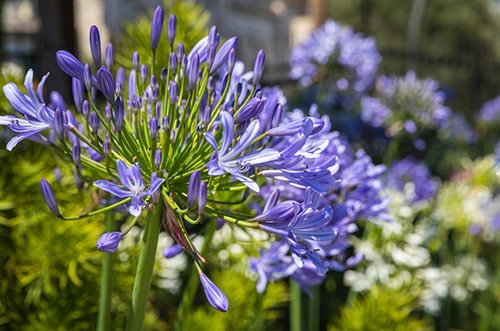
The agapanthus is a flower sometimes known as the ‘Lily of the Nile’ or ‘The African Lily’, which is native to South Africa.
These beautiful plants bloom in the summertime and have big blue flowers, which are dazzling to behold. They also come in lavender and white varieties, although the blue variations are most common. Despite the name, agapanthuses are not actually classified as lilies - instead, they’re a part of the Amaryllidaceae family.
Agapanthus plants thrive when grown in warmer climates - however, they can be grown indoors in colder countries like the UK. These pretty flowers are often seen as a symbol of love, perfect as a gift to a partner or spouse.
Agapanthuses are considered to be an invasive species in some places and can take several years to actually flower. These are things you may need to take into account if you’re planning on growing these beautiful plants in your garden. However, they’re still readily available, making for well sought-after gifts at any time of year.
Origin:All species of agapanthus are native to Southern Africa (particularly South Africa, Lesotho, Eswatini and Mozambique) although they have become naturalised in Australia, Mexico, the UK, Ethiopia and Jamaica
Vase life:Approximately two weeks
Colour range:Blue, lavender and white
Best occasion:As agapanthuses are symbols of love, they’re flowers best suited for Valentine’s Dayor as anniversary presents
Symbolism:This flower is typically considered to be a symbol of love and romance, as well as fertility, beauty and purity
Allium - the flower of humility

The allium is a flower closely linked to the onion family - it’s also considered to be a part of the Amaryllidaceae family.
Allium was first discovered in 1753 by Carl Linnaeus - since then, these plants have had a rich history across the world. There are over 500 different species of this plant across the world, with 51 genera in all.
Most varieties of the allium species are native to areas in the Northern Hemisphere, although some can be found below the equator in Africa and South America. Their flowers come in shades of lilac, pink, white and purple,sitting on long, straight stems.
Like their onion cousins, allium flowers are planted from bulbs and can be toxic to both humans and animals - something you need to be aware of if you decide you want to plant them in your garden.
Origin:Allium are usually found in the Northern Hemisphere - specifically North America, Pakistan and the Mediterranean.
Vase life:They have a long vase life, usually up to two weeks
Colour range:Lilac, pink, purple and white
Best occasion:Because they’re a symbol of good fortune and prosperity,allium bouquets are a perfect gift for a birthday, graduation gift or a promotion at work
Symbolism:They’re a common symbol of unity, also used to show good fortune, prosperity, patience and humility
Amaranth - dynamic (and delicious) delight

The amaranth is part of theAmaranthusgenus - there are approximately 75 different species of the genus overall.
Amaranths are widely spread out across the globe, being native to every continent apart from Antarctica. Their seeds and flowers are edible, but these plants can also be used as decorations or placed in bouquets, making them very versatile plants overall!
Amaranths are very pleasing to the eye, reaching up to five feet in height on occasion. Their flowers are long and hang in tassels, with the most common colours being pink, red, burgundy, crimson and bronze. They’re also classed as perennials, so once planted correctly, they’ll grow every year.
The amaranth was originally cultivated by the Aztecs and was used throughout Mesoamerica as a ritual food. It’s still used in some foodstuffs today and is a popular pick when it comes to creating decorations during the Day of the Dead festival in Mexico.
| Fun Fact:Finnish opera metal band Nightwish released a song in 2007 calledAmaranth, taken from theirDark Passion Playalbum. |
Origin:Amaranths can be found in every continent but Antarctica - 10 species are native to North America
Vase life:Between 7 and 10 days
Colour range:Various shades of red and pink, including burgundy, maroon and crimson. Bronze variations also exist
Best occasion:Festivals such as the Day of the Dead and Easter
Symbolism:Amaranths are a symbol of immortality, as they don’t fade easily and tend to retain their colouring when dead
Amaryllis - the 'sparkling' gem

Amaryllisis a small genus of plant, producing flowering bulbs with a captivating red colour that are a beauty to behold.
Other terms for the amaryllis flower include ‘belladonna lily’, ‘Jersey lily’, ‘naked lady’, ‘amarillo’, ‘Easter lily’ and ‘March lily’ - the last two names are used to refer to the plant blooming in the early springtime. These flowers are also distantly related to the true lilyLilium, although they are still distinct from one another.
Amaryllis is a bulbous plant producing at least two stems per bell-shaped flower . The flowers usually have crimson veins, with the petals themselves being a white colour, although purple, red and pink can occur at times too. The plant is native to Africa - particularly the Western Cape region of South Africa.
Amaryllis belladonnais the more popular form of the plant in the modern day, although it was only cultivated in the 18th century. This form of flower has become increasingly common within the West Coast of the USA, as the climate and ground conditions are fairly similar to parts of South Africa.
| Fun Fact:Amaryllis means ‘to sparkle’ in Greek, coming from the Ancient Greek word ‘hippeastrum’ for horse and star. |
Origin:Traditionally found in South Africa, although amaryllis is also grown in the USA now
Vase life:Up to two weeks
Colour range:White, red, purple and pink
Best occasion:Amaryllis flowers often have a bright red colour, making them suitable for the Christmas season.They’re also useful as congratulations gifts.
Symbolism:These flowers symbolise pride, as well as strength and determination
Astilbe - robust and remarkable

Astilbeis the name given to a genus of 18 flowering plants in the Saxifragaceae family.
These flowers are perennials and have a hardy nature, as they bloom in mountain and woodland regions in Asia and North America. Astilbes also have several nicknames relating to their robust constitution, such as ‘false goat’s beard’ and ‘false spirea’.
An interesting point about growing astilbes is that these flowers can survive in many different conditions, making them the perfect choice for any garden as they’re incredibly low maintenance. They can be planted in the shade or in water-logged conditions, as well as in clay soils - this makes them great for planting beside a pond.
Astilbe plumes are long and feathery,with their foliage having a ferny quality,which sets them apart from other flowers. Their flowers usually come in red, pink, white and purple colours, sprouting during the spring and summer months.
Origin:Astilbes are native to the mountain and woodland areas of Asia and North America.
Vase life:These flowers are more commonly planted in gardens than given in bouquets, but they have a vase life of around 5 days
Colour range:Pink, purple, red and white
Best occasion:These stunning flowers make great gifts for Christmas, family and friends, and are suitable for birthday presents
Symbolism:These stunning flowers are often a symbol of patience and dedication, particularly when given to a family member or a friend
Buttercup - the joy of childhood

The buttercup is one of the most popular flowers in the world- these wildflowers are native to several parts of the world, including North America, Asia and Europe.
They’re part of theRanunculusgenus, with several species of buttercup available. Some of the most common forms of the flower include the creeping buttercup (Ranunculus repens), the bulbous buttercup ( Ranunculus bulbosus), and the meadow buttercup (Ranunculus acris).
Buttercups are one of the most diverse flowers in the world as they can be annual, perennial or biennial. These plants can also bloom in terrestrial, aquatic and herbaceous settings, partly explaining their popularity within the gardens of the world.
Buttercups are usually known for their yellow colour (due to the reflective petal cells they have), but they can also come in pink, red or white. They’re also highly poisonous to both animals and humans, despite their alluring colour. They usually flower in the spring, but it’s not unheard of for buttercups to sprout during the summer months too.
| Fun Fact:The genus termRanunculusis Latin for ‘little frog’ - this is likely due to these plants flowering near areas of water. |
Origin:Buttercups are native to Europe, North America and Asia
Vase life:Anywhere between 7 to 12 days
Colour range:Yellow, pink, red and white
Best occasion:They make good gifts for children, as they’re heavily linked to childhood. They can also be given to commemorate friendships
Symbolism:Buttercups are an enduring symbol of childhood, representing friendship, joy, youth, purity and happiness
Californian Poppy - bright and beautiful

The California poppy is otherwise known as theEschscholzia californicaand is native to Mexico and North America.
These poppies are also referred to as ‘golden poppies’,as they’ve been the state flower for California since 1903. They come in white, orange, red, and yellow varieties and can be perennial or annual - depending on the climate of the area that they’re planted in.
In warmer climates, the California poppy is perennial, whereas the flower tends to grow annually in colder temperatures.
One of the most amazing things about these flowers is that their petals open when the sun is out, closing during cloudy weather or at night time. They were also used historically by Native American communities for medicinal purposes - commonly used as painkillers or anti-anxiety drugs. However, unlike other forms of poppy, the California poppy does not contain opiates.
Origin:California poppies are native to North America and Mexico
Vase life:Anywhere up to a week
Colour range:Yellow, orange, white and red
Best occasion:They bloom in spring and summer, making them perfect for displaying in your house during the warmer months. They also make nice gifts for friends and family
Symbolism:As a symbol of California and the Western USA, these flowers have become linked to the gold rush era of the nation
Celosia - the plumed beauty

The celosia is a member of the amaranth family, with the name of this flower coming from the Ancient Greek word for ‘burning’.
Celosias are native to East Africa and the Mediterranean - their Swahili name is ‘mfungu’. Other nicknames for this species of flower include ‘cockscombs’ or ‘woolflowers’. Like their amaranth cousins, the flowers of celosias are edible. Celosias are annual plants that have a high seed production count each year.
Celosias are stunning to behold, with the dazzling flowers of this plant coming in a vast array of bright colours - including purple, white, maroon, pink, yellow, orange and red. They also have various sizes and flower shapes, giving you more choice over what you plant in your garden.
| Fun Fact:Celosias are used as foodstuffs around the world. They are primarily eaten in Indonesia, India, Central Africa and West Africa |
Origin:Celosias are found within the Mediterranean area of Europe and East Africa
Vase life:They have a long vase life of up to four weeks- quite rare in the flower world!
Colour range:Yellow, orange, red, pink, maroon, white and purple
Best occasion:These flowers are perfect for weddings and anniversaries due to their links to fertility and pregnancy
Symbolism:Celosias are used as a symbol of boldness due to their bright colours. They’re also traditionally seen as a good omen for fertility
Comfrey - a diamond in the rough

Comfrey is a nickname forSymphytum, which is the genus of flowering plants within the Boraginaceae family. Comfrey is sometimes confused with the foxglove plant as it has similar leaves when not in flower. However, they’re both very different plants.
Comfrey is native to Asia, North America and Europe. There are 59 different types of flower within this family - some of them are hybrids. These plants can grow to a great height, reaching up to five feet tall at times. Their flowers bloom in a variety of colours, including purple, blue and white.
One of the things that makes comfrey so famous is that it has been used within traditional medicine for thousands of years. In Japan, the plant was called ‘knitbone’ and was used for bruises, burns and muscle pain. In Europe, comfrey was used to treat conditions like arthritis and gout. It also has an association with magic and the supernatural, which is likely due to comfrey’s medicinal link.
However, it’s also thought to be carcinogenic, so the use of comfrey has died out somewhat in recent years, especially with more advanced forms of medicine becoming apparent. This doesn’t mean that these flowers won’t look lovely in a bouquet though, as they have many purposes!
| Fun Fact:In the video gameRed Dead Redemption 2, comfrey and other herbs can be picked by the player for medical purposes, adding educational value to the game. |
Origin:Comfrey can be found in Asia, Europe and North America.
Vase life:Up to one week
Colour range:Purple, blue and white
Best occasion:Because of comfrey’s relationship with healing and magic, it would make a fantastic arrangement for Halloween and All Hallows’ Eve festivities
Symbolism:Due to its healing properties, comfrey is often linked to medicine and health. It’s also used to symbolise water and the planet Saturn, as well as having a connection to protective magic
Consolida - the flower of the heart

Consolidais a genus in the Ranunculaceae family, consisting of around 40 different species - it’s also closely linked with the delphinium flower.
Whilst it’s technically considered to be a form of delphinium, the consolida is slightly different to this plant as it only has one petal (instead of the four petals the delphinium has). The fruit also differs between the two, with the consolida producing one fruit follicle compared to the 3-5 normally produced by the delphinium.
The consolida is an incredibly popular flower and can be seen in shades of blue, pink, white, red and purple. When referring to the seeds of the plant, it’s often referred to as larkspur. These plants are native to Asia, the Mediterranean and Western Europe. They usually bloom within the springtime, extending into the summer months occasionally.
It’s a toxic plant to both humans and animals, so this is something to think about if you’re considering planting consolida/larkspur in your garden.
Origin:The consolida plant originated in Asia, Western Europe and the Mediterranean
Vase life:Vase life is usually up to one week
Colour range:Pink, white, red, purple and blue
Best occasion:These flowers work well with weddings and anniversaries due to their association with love and romance
Symbolism:Consolidas are associated with romance, love and nature
Cowslip - star of the english meadow

The cowslip is a popular springtime flower within the UK, growing within meadows and woodland across the nation. Also known as ‘common cowslip’ or ‘cowslip primrose’, this flower is related to the common primrose as part of the Primulaceae family.
As well as the British Isles, the cowslip is also native to western Asia and most of Europe. It’s usually found on open ground, such as clifftops, meadows and open fields. Cowslips are evergreen perennial plants with bright yellow flowers, although orange and red-coloured flowers can sprout eventually - however, this is rare.
The cowslip has a link to English folklore, with the flowers often being used for wedding ceremonies or May Day celebrations. It’s also been used frequently within cookery - particularly in England and Spain. Unfortunately, due to the destruction of wild habitats across the UK, the cowslip has had a rather serious decline in its population, making it much rarer than it used to be.
Origin:Whilst its associated with the UK, the cowslip is also native to the European continent and western Asia
Vase life:Up to one month
Colour range:Usually yellow, but on rare occasions orange and red flowers can sprout
Best occasion:Cowslips are often used for wedding ceremonies, as well as Easter and May Day festivities
Symbolism:The humble cowslip has a link to magic and fairies. It’s also a symbol of death, youth, grace and rebirth
Crocus - the flower of persisting joy

The crocus is a seasonal flowering plant that’s part of the iris family, with around 100 species of this perennial plant available.
The crocus can flower in most seasons, with spring, autumn and winter being the most popular times. Its flowers come in yellow, orange, white or purple varieties, although multicoloured forms do exist as well.
The crocus is also native to many parts of the world, including China, the Mediterranean, the Middle East, Central Asia and North Africa. This hardy flower can grow in a variety of different areas, such as woodland, the alpine tundra, meadows and scrubland.
As well as their pretty flowers, these plants are used in the Middle East for the production of the spice saffron. Saffron comes from a crocus variety known as the Crocus sativus. It’s thought to have been used for embalming bodies in Ancient Egypt and is also mentioned within theOld Testamentbook ‘Song of Songs’ and Homer’sIliad.
Origin:Many areas of the world, including the Mediterranean, Central and Southern Europe, Asia and North Africa
Vase life:Between 2 and 5 days
Colour range:Orange, yellow, white, purple are the main varieties, although multicoloured versions are popular too
Best occasion:They’re pretty enough to serve as floral arrangements all year round, no matter the occasion. As they sprout in spring, they’re often used for Easter decorations
Symbolism:The crocus has a rich symbolism, including joy, rebirth, innocence and new beginnings
Daffodil - the poet's inspiration
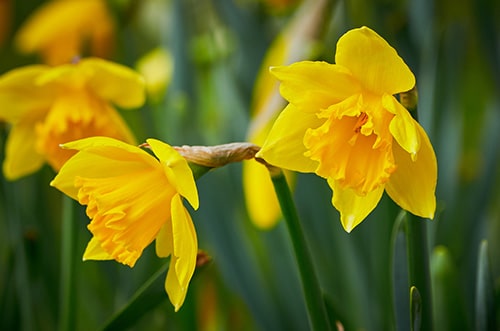
The humble daffodil is one of the most popular forms of flower at the moment - no matter whether they’re being given as gifts or are planted in your garden.
There are several different types of daffodil available - ‘paperwhites’, ‘narcissus’ and ‘jonquils’ - however, they’re all part of the Narcissus genus. Daffodils are classed as perennials, meaning they can flower each year on their own, making them effortless to grow.
Interestingly, daffodils are rarely used for pollination as they contain a natural pesticide and are grown from bulbs. They’re also considered to be pest resistant as they contain the alkaloid lycorine, protecting them from deer and rodent damage.
Most daffodils bloom between January and April, making them perfect gifts for Easter or Mother’s Day. They’re traditionally given for 10th wedding anniversaries. Daffodils are also the national flower of Wales, showing just how iconic this form of flower is.
Origin:Daffodils are native to Southern Europe and North Africa, finding a home within the Iberian Peninsula of the Western Mediterranean
Vase life: Between 7-10 days
Colour range:The yellow variety is the most common - however, they also come in white, orange and pink
Best occasion:The daffodil typically blooms in the springtime, making it perfect for Easter, Mother’s Day, or spring birthday celebrations.
Symbolism:Due to their springtime flowering, daffodils are closely associated with that season, symbolising rebirth and hope. They’re resilient flowers as they start to grow properly during winter - one of the hardest times of year for plant life to grow.
Echinacea - a herbalist's dream

Echinaceais a genus of herbaceous plants within the daisy family, commonly known as the coneflower.
Coneflowers are native to North America - particularly the eastern and northern parts of the continent. The term ‘echinacea’ actually comes from the Greek word for sea urchin, which is ‘ekhinos’. The centre of the flower is sharp and spiny, giving the flower its name. These flowers tend to bloom in the summer, although they can appear as late as September in some instances.
The flowerheads themselves are big and beautiful,with purple being the most common colour found in the garden.They’re actually considered to be a member of the sunflower family, but both types of plants are different from one another, despite the occasional similarity. They’re also drought-resistant, making them particularly hardy plants to grow in warm climates.
| Fun Fact:Echinacea was widely used within Native American folk medicine for ailments like colds, sore throats, burns, wounds, insect bites and infections. Since then, it’s been used within a variety of modern alternative medicines, although there is little evidence that it is actually effective when treating disease. |
Origin:Echinacea is native to North America - they grow in the north and eastern parts of the continent.
Vase life:10-14 days if the water is kept fresh
Colour range:Coneflowers are usually a purple colour
Best occasion:As they’re linked to health,coneflowers may make for a great get well soon gift
Symbolism:Health, healing, strength and wellbeing - likely due to their history as as a traditional form of medication
Foxglove - bumblebee's bliss

Foxgloves are another common flower, otherwise known by their genus nameDigitalis.
Foxgloves are native to many parts of the planet, including western Asia, northwestern Africa and Europe. These flowers have a unique bell shape, which makes them extremely attractive to pollinators - especially hummingbirds. They come in gorgeous hues of pink, purple, yellow and white, with different shades of each colour available.
The common foxglove (Digitalis purpurea) is a biennial plant often grown as an ornamental flower, - it looks fantastic in any garden. Foxgloves are particularly prominent within the UK, typically blooming between June and September each year.
Interestingly, foxgloves have a medicinal value and they were traditionally used by herbalists. Modern drugs, such as Digoxin, are derived from this plant and are now approved for use for heart failure. Some forms of foxglove are toxic though, so when planting them in your garden, you need to be careful which form you use.
Origin:Foxgloves are native to Europe, western Asia, and northwestern Africa. They’re also very prominent within the British Isles.
Vase life: They usually last 5-7 days when arranged in a vase
Colour range:Yellow, white, pink and purple
Best occasion:Foxgloves are often grown for ornamental purposes, so they make fantastic presents at any time of year
Symbolism:Foxgloves have quite a varied symbolism, linking to intuition, pride, creativity, energy and insincerity
Gardenia - peace and purity

The gardenia is a flower that belongs to the family of flowering plants known as Rubiaceae.
These flowers look stunning when gifted as part of a bouquet, but they can also be planted in the garden. Their stunning waxy flowers give off a gorgeous scent.
Gardenias are typically white in colour, adding a bright look to any home or garden. They can also be planted indoors or outdoors, making for a very variable flower overall.
Gardenias can be difficult to grow at times, but with a little TLC they make for fantastic bouquets, illuminating your home and adding a luscious smell that will entice any onlooker.
These plants also have many other uses - in Eastern Asia, they’re often used to create a dye, which can then be added to food or clothing to enrich the colour. In Hawaii and France, Gardenias are used as clothing accessories, making the wearer stand out.
Origin:Gardenias are native to many areas of the world, including Asia, Madagascar, the Pacific Islands, Africa, and Australia
Vase life: Optimum vase life is between 1-3 days
Colour range:White, yellow
Best occasion:Gardenias are often grown for ornamental purposes, so they make fantastic presents at any time of year
Symbolism:Because of their light colouring, gardenias are often associated with joy, purity, and peace
Geranium - hope of home and hearth

Geraniumis actually a term used to refer to a large genus of 422 species of different flowering plants, known simply as geraniums. Geraniums are also sometimes referred to as cranesbills.
With so many different varieties of this flower available, they can be native to several regions of the world. However, they tend to bloom in warmer climates, such as Australia, South Africa, the tropics and the Mediterranean. As well as being grown outdoors, geraniums can also be grown indoors as houseplants, adding more versatility to this plant.
Geranium flowers can come in white, violet, red or pink, with multicoloured varieties also available.
Some geraniums are scented - they’re often used within food or beauty products, as well as insect repellents in some parts of the world. These flowers are well known as anniversary presents, particularly linked with the fourth anniversary for a married couple.
Origin:Geraniums flourish in warmer, more temperate climates - particularly the tropics, Central and Southern Europe, South Africa and Australia.
Vase life:They have quite a long vase life of between 1 and 2 weeks
Colour range:Typically white, violet, red or pink, although varieties with more than one colour are possible too
Best occasion:Geraniums are traditionally used as a fourth anniversary present for a spouse, but they are also popular for weddings
Symbolism:These plants are linked with trust, friendship, beauty and steadfast piety
Gerbera Daisy - the perfect pop of colour

The gerbera daisy is also commonly known as the African daisy due to this flower blooming in South Africa. However, whilst it is native to Africa, the plant has since been introduced into Asia and Latin America.
Gerbera daisies were first described in 1889 by Joseph Dalton Hooker for Curtis’ Botanical Magazine - Hooker was a British botanist and explorer during the Victorian era. These plants were brought to England after being discovered in South Africa, with their popularity soon spreading further into Europe.
The Netherlands is now one of the biggest gerbera daisy distributors in the world, stemming from this initial introduction decades ago.
Gerbera daisies are perennial flowers that bloom in a multitude of different colours - including pink, orange, yellow and red - although the centre of the flower is often black.
Origin:These plants were originally native to South Africa, although they’ve spread massively since then
Vase life:Between 1 and 3 weeks
Colour range:Pink, orange, yellow and red
Best occasion:Gerbera daisies are often used for happy occasions, such as weddings or birthdays, due to their bright flowers
Symbolism:These flowers have different symbolism depending on the colour of the flower. Pink is a sign of adoration and admiration; red is a symbol of love; yellow is a symbol of joy and celebration
Glory of the Snow - a dazzling carpet of flowers

The glory of the snow (otherwise known asScillasectionChionodoxa) is a small selection of flowering plants within the asparagus family.
These bulbous perennial plants would make for an unusual addition to a bouquet - whilst they’re unique when compared to some of the other flowers on this list, they’re no less satisfying to view. Glory of the snows are based in the eastern Mediterranean area - specifically Turkey, Cyprus and Crete.
These flowers are named glory of the snow due to their hardiness, growing in alpine regions of the world during the winter time.They bloom in the springtime, making them perfect for Easter celebrations. Their flowers have a lovely star shape, usually coming in the following colours: white, yellow, pink and blue.
These plants seed themselves and spread very easily, so you need to be careful that they don’t take over other parts of your garden if you choose to grow them. However, they’re suitably stunning flowers when gifted in a bouquet.
Origin:The eastern part of the Mediterranean, particularly Turkey, Cyprus and Crete
Vase life: Between 5 and 10 days
Colour range:White, yellow, pink and blue
Best occasion:Easter and Mother’s Day are the best occasions to gift these plants
Symbolism:Because they grow in the winter and bloom in the spring, glory of the snows are another flower known for symbolising new birth and hope
Hollyhock - the flower of ambition

The hollyhock is a classic cottage garden flower,alternatively known by its genus name,Alcea.
Hollyhocks are known for their tall stature, usually flowering in the second year after seeding. However, these plants may occasionally flower in the first year if the seeds have been sown early enough in the season.
Hollyhocks can be annuals, perennials or biennials - they can also be used for food, as well as decoration. They’re native to Asia and Europe, although another species of the flower belonging to a different genus can be found in North America, known as the streambank wild hollyhock.
The petals of the hollyhock can be either white, purple, yellow or pink and have a notched pattern. They’re common ornamental plants found in gardens, although they work well when put into bouquets too.
In Victorian England, the hollyhock was part of the language of flowers, symbolising ambition, fertility and fecundity.
| Fun Fact:Japan has a hollyhock festival each year, known as Aoi Matsuri. The festival is held in the city of Kyoto and occurs on the 15th May each year. Aoi Matsuri is thought to have ancient origins, starting during the reign of Emperor Kinmei. |
Origin:True hollyhocks are native to Asia and Europe
Vase life: They can last up to 15 days if cultivated correctly
Colour range:Pink, yellow, purple and white
Best occasion:Because of their link with fertility and ambition, hollyhocks would make a good present for several occasions. They’re often used at weddings, but they can also be used to congratulate - for example, a promotion present
Symbolism:Ambition, fertility, fecundity
Hyacinth - the symbol of rebirth

The hyacinth comes from the genus Hyacinthus, consisting of a selection of bulbous perennials.
Originally, these plants were native to the Mediterranean region between Turkey and the Middle East. However, they’ve since been localised to several other areas - including North America, Korea, Europe and Mexico. Around 60 different cultivars exist in the present day.
Hyacinth varieties bloom with pink, red, yellow, white, purple and blue flowers - they can be grown both indoors and outdoors.As well as their beautiful colours, these plants are also known for their sweet smell, being one of the main features that attracts people to them.
However, whilst they may smell great, these plants (particularly their bulbs) are highly toxic and poisonous, so they shouldn’t be eaten.
The hyacinth is another flower associated with rebirth and the springtime, as this is the time of year when this plant blooms.
| Fun Fact:A character from the television showKeeping Up Appearanceswas named after this flower as a fun play on words. The name was ‘Hyacinth Bucket’, with the character instead pronouncing her surname as ‘Bouquet’ in an attempt to sound posh |
Origin:Hyacinths are native to the Mediterranean - particularly Turkey, Syria and Lebanon
Vase life:Usually between 7 and 10 days
Colour range:They have a huge variety of colours, including red, yellow, pink, white, purple and blue
Best occasion:As springtime flowers,hyacinths are perfect as Easter gifts. Their link to love and commitment also makes them suited to weddings and anniversaries
Symbolism:Peace, commitment, beauty, power, happiness and love.
Kale - a vibrant vegetable

Kale is more commonly described as a vegetable from the cabbage family - however, it’s also a rather beautiful flower, known as flowering or ornamental kale.
The typical kale colours are pink, red, white, lavender, blue and purple, adding a vibrant look for any time of year. The plant originated in the Mediterranean and Anatolia - now an area considered to be part of modern-day Turkey.
Whilst flowering kale is edible, it’s a little different to the more common form of the plant you’d find on your dinner plate , having a bitter taste. Because of this, it’s important not to get the two mixed up.
One of the more interesting things about flowering kale is that this plant thrives in colder temperatures - it normally blooms in spring and autumn but can also withstand some winter climates. The colours of this flower are more vibrant in cooler weather, making for a perfect addition to any garden once your other flowers have started to fade.
Origin:Kale originated in Anatolia and the Mediterranean
Vase life:Typically between 7 and 10 days
Colour range:Kale comes in many different colours, including red, white, lavender, blue, purple and pink
Best occasion:Kale is often used for vegetable bouquets, but its year-round growth means it can be used for almost any occasion
Symbolism: Kale has an interesting Halloween connection , associated in Ireland with fortune-telling and the supernatural.
Pansy - the nostalgic pick

The pansy is another popular flower found in gardens around the world. It is native to Europe and Asia and is technically classified as a short-season perennial flower, although it’s often grown as annuals instead.
Pansies are grown as perennials in colder climates and annuals in more temperate areas, so the way you grow them will depend vastly on where you live. They tend to bloom in the following colours: blue, purple, white and yellow. Some variations may feature more than one colour.
The garden pansy is actually a hybrid plant, created by mixing the sectionMelaniumwith the genusViola. Pansies, as we know them today, were formally introduced to the world in 1812, becoming a firm favourite since then.
The pansy also became popular in Romantic poetry and literature with authors such as Nathanial Hawthorne and D. H. Lawrence mentioning this flower within their work.
| Fun Fact:In Germany, Scandinavia and Scotland, the pansy became known as the ‘stepmother’. This was due to the emergence of nursery rhymes, at the time, about wicked stepmothers. |
Origin:Pansies are native to Asia and Europe
Vase life:On average - around two weeks
Colour range:They can come in multicoloured or single colour varieties, including yellow, white, purple and blue
Best occasion:Pansies are perfect for ‘get well soon’ gifts, but can also be used for anniversaries and remembrance events as they have many different meanings
Symbolism:They’re historically a symbol of remembrance, nostalgia and unrequited love
Pampas Grass - the 'feathery' favourite

Pampas grass may seem like a strange addition to this list, but it can be used suitably in a bouquet for many an occasion!
Otherwise known asCortaderia selloana,pampas grass is native to South America - it’s actually named after the Pampas region that spreads across the continent. This attractive ornamental grass flowers in September and is usually white, although pink varieties can occur.
Pampas grass is very tall and grows at an incredibly fast rate. Because of this, it’s actually considered to be an invasive species in New Zealand, Hawaii and other parts of North America. Whilst it can have a negative effect on local wildlife and fauna, herbicide treatment is used to slow invasion, alongside cutting the grass itself.
However, this is something you’ll want to think about before deciding to grow pampas grass yourself. Instead, why not consider a nice bouquet instead? When preserved properly, this foliage can last for up to three years when cut, making it an extremely worthwhile decorative piece.
Pampas grass became an incredibly popular interior design trend in 2018, and it’s showing no signs of slowing down yet! It’s also a little different to the current flower norms, making your home really stand out from the crowd.
Origin:South America - particularly in the Pampas region
Vase life: Pampas grass has an extremely long vase life - between 2 and 3 years if treated carefully
Colour range:Mostly white, but pink varieties do exist
Best occasion:Pampas grass is perfect for any wedding event, but it’s especially pretty when used for a summer wedding. You can also use it for harvest festivals and general home decoration
Symbolism:Fertility, happiness, love, romance
Periwinkle - a star of spring

The periwinkle is also sometimes known as the ‘Myrtle’ (Vinca minor) - although periwinkle is its more common name. Another common variation of this plant is the Greater Periwinkle (Vinca major).
These flowers typically bloom in the springtime, with April and May being the most common months. These tiny plants have over 30 different varieties, though the more common colours include blue, purple, burgundy, lavender, and white.
Some varieties of periwinkle have something known as ‘variegated leaves’ - this means that their leaves can flower in multiple colours on the same plant, adding a nice touch of variety to any bouquet. As well as being perfect gifting flowers, periwinkles also work well when placed in the garden, acting as a form of erosion control.
These flowers are typically planted on graves or used for funeral wreaths, due to their connection with loss and remembrance. However, they’re still gorgeous enough to use in other settings, so you don’t need to feel limited when gifting periwinkles.
Origin:Periwinkles are native to Europe, being particularly common within the British Isles
Vase life: This depends on the flower type, but usually between 4-7 days
Colour range:Blue, purple, lavender, burgundy, white
Best occasion:Periwinkles are associated with loss and death, so they’re often used at gravesites or as funeral wreaths
Symbolism:Whilst periwinkles have a common association with funerals and death, their springtime blooming is also linked to regeneration and new life. Their delicate pastel colours are also sometimes associated with peace and serenity, making them very versatile.
Petunia - a kaleidoscope of colour

The petunia is another common flower staple within the modern world - it’s actually a genus of 20 plant species.
Petunias are native to South America and also have a link to several vegetables - including tomatoes, aubergines, peppers and even tobacco. They can be grown as annuals or perennials, adding much variety to this form of plant.
These plants have many different uses - they’re often grown in gardens, used in hanging baskets or put into planters. However, their amazing colour scheme means that these flowers also look perfect when arranged in a bouquet. Petunias have a stunning smell, attracting onlookers from far and wide.
Petunias are very vivid to look at and can be found in the following colours: yellow, pink, red, lavender, purple and white. They can also come in multicoloured or striped varieties, adding an edge to your garden. They’ve got quite a long blooming life, lasting from spring right through to autumn, if cultivated correctly.
| Fun Fact:Petunia Dursley in theHarry Potterseries was named after this flower. In the series, Petunia resents her sister Lily for having magic powers when she doesn’t, showing how the original symbolism of the flower is still being used today |
Origin:ThePetuniagenus is native to South America
Vase life:Around 4-6 days
Colour range:Petunias can be found in multicoloured or striped varieties. They can also bloom with single colours, such as pink, red, yellow, purple, white and lavender
Best occasion:Petunias are great for weddings or anniversaries
Symbolism:Petunias used to be a symbol for anger and resentment, but this meaning has changed over time. In most situations, they’re now used to symbolise desire and hope
Primrose - the first of spring

The primrose is another staple of the cottage garden - however, it can also be grown indoors if you wish. It’s native to Europe, Africa and Asia, although this flower is particularly renowned within the British Isles - the flower is often nicknamed ‘the English primrose’.
These flowers are sometimes formally referred to by their Latin name Primula vulgaris, as well as the common primrose (due to how popular they are). Primroses are perennial woodland plants that have a tiny stature, growing no taller than 10cm high in total.
Primroses have long been known as a symbol of the springtime as they’re often one of the first woodland flowers to sprout each year. However, they can bloom right through from December to May, showing just how versatile these little flowers are!
Primroses are known for their pale colour scheme, often combining two different shades together. They’re generally yellow, although some varieties may have white and pink forms. The scientific name for the primrose,Primula,comes from the Latin for the word ‘first’ due to this flower being one of the first to bloom each year.
Origin:The primrose can be found in western and southern Europe, southwest Asia and northwest Africa
Vase life: These flowers can last up to one month in a vase
Colour range:Typically yellow, but white, pink and multicoloured versions sometimes occur
Best occasion:The primrose usually blooms in spring, making it perfect for Mother’s Day or Easter celebrations
Symbolism:Rebirth, regeneration, youth, renewal and optimism
Snowdrop - the promise of new beginnings

Otherwise known as theGalanthus, the snowdrop is a small genus of around 20 herbaceous perennial plants grown from bulbs.
One reason these plants are so special is the fact that they flower in winter, giving them the nickname snowdrop. Snowdrops tend to flower in January and February, but in recent years some sprouts have been flowering in December and even November, which could be related to climate change.
The snowdrop is considered to be one of the first signs of spring. These plants are fairly small, having white bell-shaped flowers. They’re native to Europe and the Middle East, although the snowdrop is also widely connected with the UK. Interestingly, these flowers were not recorded as wildflowers until the 18th century, spurring questions about when they were introduced into the nation.
This flower has a great mythological significance, with the sight of the first snowdrop once considered to be a sign that winter was over, signalling hope for the future. However, seeing one snowdrop on its own is also a symbol of death, and it was considered bad luck to take these flowers into your home.
Origin:The snowdrop is considered to be a British flower, but it also grows in continental Europe and the Middle East
Vase life:Up to two weeks, depending on when they’re cut
Colour range:White
Best occasion:Snowdrops are often used for Candlemas services, as well as Easter when it falls early in the year. They’re also great for birthday celebrations in January and February
Symbolism:New beginnings, hope, rebirth, death
Tansy - the yellow wonder

The tansy is a perennial, herbaceous plant that is part of the aster family. Other nicknames for tansy include ‘common tansy’, ‘bitter buttons’, ‘golden buttons’ and ‘cow bitter’.
Tansy is native to the warm areas of Europe and Asia, although it has been introduced to other parts of the world, such as North America. This plant has yellow flowers that look like buttons, hence the nickname ‘golden buttons’.
Tansies generally appear in clusters between July and October.They’re also very low maintenance, as they self-seed and spread their seeds quickly.
These plants have a long history of being used for medical purposes, grown as medicine since at least the 8th century AD. Some of the many ailments that tansies were thought to help with include rheumatism, intestinal worms, fever, sores, digestive issues, measles and joint pain.
Tansy has also been used as an insect repellent and an embalming tool, as well as being used throughout the funerary process. It also used to be commonly added to food, although tansy toxicity can occur and you can develop contact dermatitis when handling tansy a lot, so this doesn’t come recommended.
Instead, why not add this wonderful flower to a beautiful bouquet?
| Fun Fact:The name ‘tansy’ is actually derived from the Greek word for immortal - Athanaton. This is due to tansies having a long lifespan and being commonly used at funerals. |
Origin:Tansies are common across most of Europe and Asia - particularly in the warmer areas
Vase life: They have quite a long vase life of between 7 and 10 days
Colour range:Yellow
Best occasion:Tansies have long been associated with death and funerals, making these flowers perfect for funeral wreaths or consolation gifts
Symbolism:Immortality, war, death, hatred and resistance
Violet - 'our lady of modesty'

Violets are one of the most common flowers in the world, famous for their beautiful purple colouring. They’re part of theViolagenus in the violet family Violaceae.
There are over 500 varieties of these wildflowers available, with the most common forms blooming with lavender, purple, white, or yellow flowers. Whilst they’re often grown outside, they can be picked to create a wonderful bouquet of flowers, suitable for any occasion.
The violet is the birth flower for the month of February and is also the national flower of several American states - New Jersey, Illinois, and Wisconsin. Violets have been cultivated since at least 500 B.C.and have many applications beyond just looking good. These plants are commonly used in medicine or food, due to their unique flavour palette.
Origin:Most violet varieties can be found in the temperate regions of the Northern Hemisphere, although they are also common in places such as Hawaii, Australia, and the Andes mountain range.
Vase life: Typically between 2-3 days
Colour range:Lavender, violet, purple, white, yellow
Best occasion:Violets tend to flower during January and February, making them perfect gifts in the early springtime. They’re commonly used as Easter decorations
Symbolism:As these flowers bloom in the springtime and are often used during Easter festivities, they’re another plant used to symbolise new birth and hope. They have a common connection with Christianity and are linked to the Virgin Mary, often connected with wisdom and faith.
Yarrow - the flower of 'Achilles'

The yarrow (otherwise known as theAchillea millefoliumor common yarrow) is a perennial plant found in the aster family.
Yarrows grow in clusters and are native to temperate regions of Asia, South America and the European continent. These small flowers come in the colours of red, yellow, white, pink, purple and orange - typically blooming in the summer months.
Yarrow is very attractive to pollinating insects such as bees. These flowers are also sometimes used as livestock feed in Australia and New Zealand. However, yarrow can be toxic to horses, cats and dogs, so it shouldn’t be fed to these animals. It can also cause allergic reactions in humans, so you should consider wearing gloves before working with yarrow.
Interestingly, yarrow was traditionally used by Native American nations for medicinal purposes, including as a painkiller or a sleep-inducing drug. Yarrow was also used in the Middle Ages to make beer bitter before the invention of hops.
Origin:Yarrow is mostly native to the Eurasian continent, although some varieties exist in South America and North America
Vase life:Between 1 and 2 weeks
Colour range:Red, yellow, pink, purple and orange
Best occasion:Yarrow flowers make for great gifts when congratulating someone, due to their relation to bravery
Symbolism:Yarrows are a symbol of courage, bravery and heroism, as well as magic. The nameAchillea millefoliumcomes from the Greek hero Achilles.
Zinnia - bold and beautiful

Zinniais a genus of plants found within the Asteraceae family, native to the southwestern part of the USA, as well as Mexico and South America.
These plants tend to grow in warm climates - particularly within dry grass and scrubland. Zinnia plants are able to withstand very hot temperatures and reseed themselves each year, meaning they’re fairly effortless to grow.
Zinnia flowers are a beginner’s dream, as they’re relatively easy to grow yourself, especially if you’re new to the gardening game. So long as the dying blooms are deadheaded (when the dead flowers are removed from a plant), they can bloom all year round.
These bright flowers are herbaceous annuals and typically bloom in red, yellow, pink, purple, orange and red flowers. They’re also particularly attractive to pollinators like hummingbirds, making them perfect for any modern garden.
Origin:Zinnia is found in Mexico, South America and the USA
Vase life:Usually between 7 and 12 days
Colour range:Red, yellow, pink, purple, red and orange
Best occasion:Zinnia are great floral gifts for birthdays, anniversaries and wedding presents
Symbolism:These plants are associated with friendship, endurance, goodness and lasting affection
Laelia - a blushing beauty

Laeliais a genus of 25 flowering plants in the orchid family. They typically grow in areas with a subtropical or temperate climate and are native to Mexico, as well as other areas in South and Central America.
These plants bloom in a wide range of places across America, including forests, mountains and lower elevations. Two of the most common forms of laelia are theLaelia albida(found in Mexico) and theLaelia anceps(grown in Honduras and Mexico), although several other varieties also exist.
Laelias have a wide colour variation, which differs depending on the different species of plant within the genus. Their flowers typically come in white, pink, violet, purple, red, blue and grey colours, making for some beautiful bouquets.
As well as being grown in the ground, laelias can also flower when attached to tree trunks and branches, making them very versatile. They usually bloom in autumn and winter and have been crossed with theCattleya,Sophronitis, andBrassavolaspecies to create some stunning looking orchid cross breeds.
Origin:Central and South America - particularly Mexico
Vase life:From several days up to a few weeks, depending on the flower
Colour range:Laelias have a varied colour scheme, including pink, white, violet, blue, grey, red and purple
Best occasion:As laelias are a symbol of fertility and love, they make great anniversary presents or spousal gifts
Symbolism:Fertility, happiness, beauty, love, refinement and thoughtfulness
Nemophila - the 'woodland loving' flower

Nemophilais a flower genus found in the plant familyBoraginaceae.
There are many different types of nemophila found in the wild, usually containing the phrase ‘baby blue eyes’ within their common names, due to the vivid blue colouring the flowers typically have. The nemophila species is native to North and Central America - whilst some varieties can be found in Mexico and the southeastern part of the USA, they’re more commonly grown in the western part of the nation.
Nemophilas are annuals, usually blooming in the springtime. These plants come in blue, white or purple colours and typically have a bell shaped flower, surrounded by five petals.
They’re also fairly easy to grow for newcomers to the gardening world,as they don’t require pruning and tend to be disease free.However, aphids like to eat and attack nemophilas, so this is something you need to be aware of if you decide to grow them in your garden.
| Fun Fact:The term nemophila comes from a combination of two Greek words - ‘némos’ (meaning ‘wooded pasture’) and ‘philos’ (meaning ‘loving’). Because of this, the word nemophila means ‘woodland-loving’. |
Origin:Nemophilas are native to the USA, although some varieties do grow in Mexico
Vase life:Up to one week
Colour range:Nemophilas are typically blue, although they can also come in white or purple colourations
Best occasion:Blooming in the springtime, nemophilas make for good Easter bouquets. Their link to prosperity and wealth also makes them perfect as career or promotion presents
Symbolism:The term nemophila means ‘success everywhere’ in flower language, symbolising prosperity, success and wealth
Feverfew - 'you light up my life'

A charming little flowering plant, feverfew is native to Europe and Asia. It's known for its delicate, daisy-like flowers that bloom in shades of white and yellow. The whole plant smells a bit like citrus when crushed, which makes it a great addition to the garden or inside your room as part of a flower arrangement.
Feverfew has been used for centuries as a herbal remedy for headache pain and stomach upset, as well as an insect repellent. It's also said to help treat menstrual cramps.
Feverfew flowers are a popular choice for bouquets because of their cheerful, daisy-like appearance and their versatility. The small blooms are often used to add texture and depth to bouquets and make for wonderful wedding flowers all year long.
Origin:Feverfew grows in the wild throughout Europe and North America.
Vase life: These flowers can be kept in water for up to 3 days.
Colour range:The most common type you will find are those grown in yellow clusters with white petals.
Best occasion:The best occasion to use feverfew flowers is on Mother's Day or at a baby shower because it represents motherhood and new beginnings.
Symbolism:Because of this flower’s medical properties, this flower is commonly associated with wellness, strength and healing.
Bluebell - humility and constancy

Bluebells are known for their beautiful, bell-shaped flowers, which are typically white or striking cobalt blue or purple in colour, although some varieties may be grey or softer shades of lilac. These delightful, dainty flowers grow on tall, slender stems and are often arranged in clusters.
Forests are the most common habitat for bluebells in the wild, where they grow in large drifts. They are also commonly grown in gardens and are often used in bouquets and floral arrangements.
In addition to having a delicate, sweet scent, bluebells are often compared to hyacinths due to their similar fragrance. Although we love these beautiful flowers, bees and other pollinators also love them, making them valuable plant species!
Because of their ethereal nature and fragrance, they make wonderful additions to Spring flower bouquets.
| Fun Fact: Bluebells used to ring at dawn to call fairies into the woods, according to folklore! |
Origin:They are native to Europe, North Africa, and the Middle East, and are widely cultivated in other parts of the world as ornamental plants.
Vase life: 1-2 weeks
Colour range: Most common colour is surprisingly white, followed by various blue and purple hues.
Best occasion: Romantic occasions. Bluebells are often associated with love and romance, making them a great gift for someone you care about.
Symbolism:Gratitude, humility, everlasting love and loyalty.
Bird of Paradise - a truely tropical show-stopper

Are you ready to add some tropical flair to your garden or home? Look no further than the majestic bird of paradise (strelitzia reginae)! This show-stopping plant is native to South Africa and is known for its vibrant, orange and blue flowers that resemble the head of a tropical bird.
The plant produces showy, orange and blue flowers that are shaped like the head of a tropical bird, with a long, curved beak and bright, orange ‘feathers.’ It’s this appearance that also gives them their alternative name of ‘the crane flower’. The flowers are typically about 25 cm long and are held high above the plant on long, slender stalks.
With long, glossy leaves and towering, slender stalks, the bird of paradise is sure to turn heads and add some style to your space.
The bright orange colour is often associated with warmth, cheer, and tropical environments, while the blue colour is often associated with tranquillity and relaxation.
Origin:Due to its requirement for sunny and warm conditions, the plant can be found mostly in America and Australia.
Vase life: Blooms used in a flower bouquet can last up to 2 weeks.
Colour range: Typically orange and blue, with a long, curved beak and bright, orange feathers.
Best occasion:If you find yourself celebrating 9 years with your loved one, this flower is the official flower for this milestone - consider this plant for an anniversary.
Symbolism:Freedom, joy, love and paradise.
Heather - flowers of faerie

Heather flowers are a member of the Ericaceae family and grow on bushes in open areas. They have a bell-shaped bloom that's usually white or pink, and they can grow up to six feet tall.
Due to its popularity, heather has been cultivated to grow in a wider range of colours including white, yellow and red.
Heather flowers are a popular choice for bouquets because of their delicate, romantic appearance and their versatility . The small, bell-shaped flowers are often used to add texture and depth to bouquets, and they are available in a range of colours including pink, purple, and white, which allows for a wide range of colour combinations.
In addition to their appearance, heather flowers are also long-lasting and easy to care for, making them a practical choice for bouquets. They are resistant to wilting and can last for several days in a vase with proper care.
Overall, heather flowers are a beautiful and versatile choice for flower bouquets. Their delicate, romantic appearance and long-lasting nature make them a popular choice for a wide range of occasions.
| Fun Fact: Heather can be used topically in skin care products and as infusions. In the past, strong tea was brewed and added to baths. Herbs, honey, syrups, and brewing recipes can also benefit from Heather flowers. |
Origin:The heather flower is synonymous with Scotland where it grows wild in the heaths and moors but is also found in North America, New Zealand and the Falkland Islands
Vase life:Cut heathers can last anywhere between 6-10 days.
Colour range:It is known for its small, bell-shaped flowers that bloom in shades of pink, purple, and white.
Best occasion:Pink heather is representative of femininity and purity, making them ideal for mother’s day. They are also perfect for a late summer wedding when its beautiful flowers appear
Symbolism:Good luck, purity, and passion
Blue Puya - strange and striking

When it comes to unique flowers, this unusual plant certainly stands out. There are around 199 species within the Puya genus and it traditionally grows in the Andes mountains of Peru, Bolivia, Chile and Argentina. It is related to the pineapple family (which may come as no surprise). This striking plant features sky-blue bracts that surround a yellow centre.
One of the most interesting facts about this plant is that some variants are protocarnivorous.Therefore, animals can become trapped and entangled in their spines, and die as a result. Afterwards, they decompose and provide nutrients to plants through the soil, while also protecting them from grazing animals as they decompose.
The deep blue flowers of blue puya are a stunning and distinctive addition to any flower arrangement. They pair well with white or light-coloured flowers, as well as with other shades of blue. Consider mixing this distinctive plant with softer, more delicate flowers to create a balance of texture and form.
Origin:Flowers of this type are native to South America and grow in high elevations of arid Chile
Vase life:These flowers aren’t often seen outside of their natural environment, but take up to 10 years to bloom in the wild!
Colour range:This eye-catching flower comes in electric blue and sky blue colours
Best occasion:The vibrant energy that these plants give off makes them perfect for all occasions, they make particularly thoughtful gifts during difficult times.
Symbolism: The blue puya flower represents loyalty, friendship, and peace.
Darwin’s Slipper - bold, fun and distinctive

The epitome of tropical beauty - meet the gorgeous flower that is darwin’s sipper (formally named calceolaria uniflora).
One of the best things about Darwin's Slippers is its playful, slipper-like flowers. These flowers are about 2.5 cm long and are shaped like a slipper or boot, with a wide base and a narrow, pointed tip.
The plant comes from the family Primulaceae, which means it's closely related to primroses. It was first discovered by Charles Darwin in 1835 on his voyage around the world.Since then, it has been found in many different areas of the world - but it thrives best in tropical climates. The plant gets its name from its unique ability to sip water droplets from surrounding leaves, which allows it to survive even during dry seasons.
It is common to see these unusual flowers throughout the summer. A canopy of pouch-like blooms is about 2 inches high, and it hangs from 4-5 inch tall stems. In addition to burgundy markings above and below the open ‘mouth’, they have a white band across the surface.
Origin:This beautiful flower is native to South America, but can be found growing in warm climates all around the world.
Vase life: Calceolaria uniflora vase life is a little over two weeks.
Colour range:The flowers are usually a bright orange or yellow colour that is cheerful and eye-catching.
Best occasion:The vibrant red and orange colour of these flowers makes them ideal for birthdays and any other happy occasion.
Symbolism:Darwin’s Slippers are a symbol of evolution. They represent the journey from start to finish, from the birth of a baby to its deathbed.
Plumbago Auriculata (Cape Leadwort) - a version of lilac and blue

If you’re a fan of dainty purple flowers, you will adore these lilac blooms. Tiny, delicate and elegant, cape leadwort are flowers that are sure to captivate when added to a garden of flower arrangements.
Plumbago auriculata, also known as plumbago or leadwort, is a perennial flowering plant from the Plumbaginaceae family. It is native to South Africa but can be found growing in other parts of the world as well. It grows up to 1 metre tall and has blue-grey flowers that bloom in clusters. The flowers can be used in fresh arrangements or dried for use in wreaths and bouquets.
In terms of symbolism, plumbago flowers are often used to represent hope and perseverance. They are also associated with faithfulness because they bloom even when they face harsh conditions such as drought or cold weather.
Origin:This flower is native to South Africa and thrives in sandy, rocky soil
Vase life: These flowers require careful care and maintenance to thrive, but can last around 2 weeks when cut.
Colour range:Blue and purple hues.
Best occasion:In many countries around the world, it's customary to give a bouquet of these flowers at weddings or other important occasions to show how much you care about someone else's happiness!
Symbolism:The blue plumbago flower represents strength and determination. It can also symbolise deep-rooted spiritual beliefs that bring peace and serenity to one's life.
Zygopetalum Orchid (Zygopetalum) - sleek and stylish

Searching for something striking and bold to adorn your home, yet relatively easy to look after? Then, look no further than the Zygopetalum Orchid (also known as the 'Zygo'). This tropical flowering plant originates from the mountains and rainforests of South America. The name 'Zygopetalum' comes from the Greek 'Zygon', meaning yoke and 'petalon', meaning petal, emphasising the way the petals are attached to the callus like a yoke.
Zygo orchids are incredibly distinctive, growing as high as a foot with beautiful, long leaves. Their flowers are unmistakable due to their stunning indigo veins and patterned petals which come in a variety of colours including white, purple and brown which can grow to a diameter of 3 inches.
There are a variety of species and therefore, it's important to do some research to determine the easiest to grow in your environment. As the blooms grow from spikes, when purchasing, avoid any which have only a few spikes. Due to their origin, Zygo Orchids require lots of natural light and humidity as well as generous and regular watering.
Origin:Central and South American countries such as Peru, Brazil and Paraguay
Vase life:2-3 weeks
Colour range:Mauve, purple, brown with beautiful patterns from striped to leopard
Best occasion: Makes a beautiful addition to any orchid arrangement as they're long-lasting and have a distinctive sweet scent.
Symbolism:Fertility and spirituality between people
Chocolate Cosmos - deliciously scented

The Chocolate Cosmos plant is so-named because of its heady vanilla-chocolate fragrance and although we wouldn't recommend eating them, these marvellous maroon flowers are surely a conversation starter.
The Chocolate Cosmos is unique in its propagation as the seeds are sterile and so it is necessary to look for roots which show new growth. They like well-drained, fertile soil and require lots of light so place them in an area which attracts the most sunlight. Do not over-water as saturating them will kill the roots so remember to let the soil dry before re-watering. When grown within a border, it's best to place them towards the front.
Once the flowers appear in early June, it is best to avoid a windy locale as they are delicate but will be very popular with the bees due to the richness of their pollen.
Origin:This flower originates from Mexico and South America
Vase life:6-7 days
Colour range:from deep red to maroon, with some species almost black
Best occasion:Due to its chocolate scent and rich red colour, the Chocolate Cosmos is often gifted to represent everlasting love and is a popular gift for Valentine’s day.
Symbolism:In Mexico, this cocoa-coloured flower represents harmony and order. It can also be associated with feelings of deep love and passion.
With your new-found knowledge of flower types, it’s time to discover our beautiful bouquets
The world of flowers is stunning, magnificent, and overwhelming, we're sure you'll agree! Our goal is to help you form a decision on the best types of flowers to purchase for almost every occasion possible by providing this guide.
Here at Direct2Florist, we believe that your local florists have the best ideas about what kinds of flowers work best in your area and that they can create arrangements that are unique and beautiful. That's why we work with them - to make sure that when you need a bouquet, you get one that's perfect for your event.
Whether you’ve found a ready-made bouquet available on our website, or have your own ideas for a bespoke floral arrangement, it’s time to locate your local florist by entering your delivery postcode.
We’ve got you covered when you need next-day delivery, same-day delivery and even international delivery!
So, what are you waiting for? Find the flower bouquet of dreams and get it delivered right to your door.